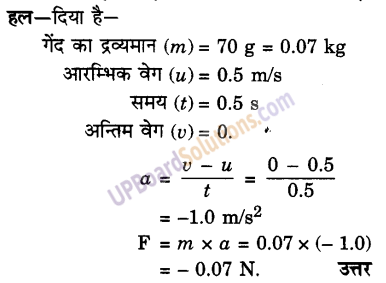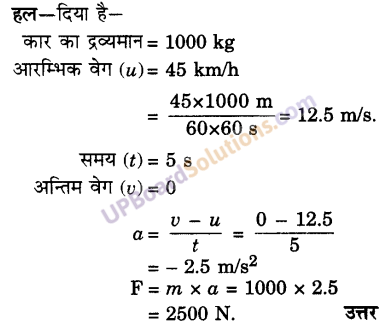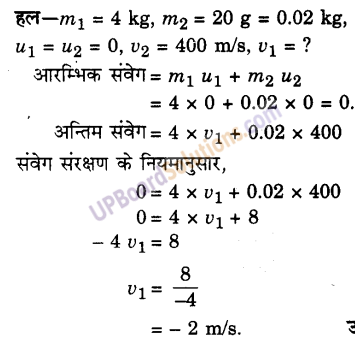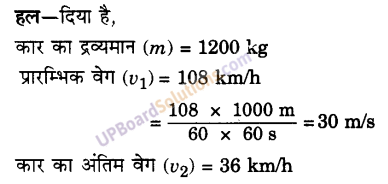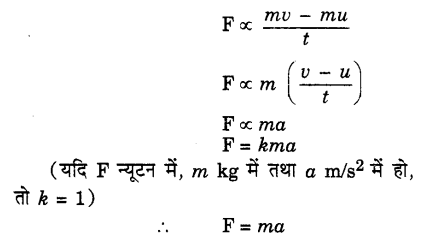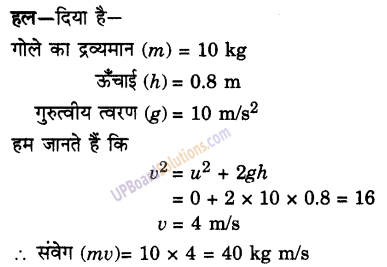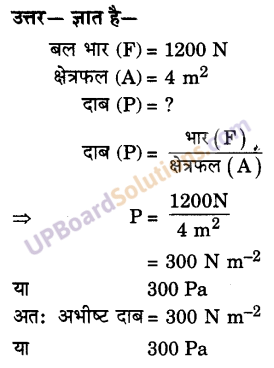UP Board Solutions for Class 9 Science Chapter 11 Work, Power and Energy (कार्य, शक्ति और ऊर्जा)
These Solutions are part of UP Board Solutions for Class 9 Science. Here we have given UP Board Solutions for Class 9 Science Chapter 11 Work, Power and Energy (कार्य, शक्ति और ऊर्जा).
पाठ्य – पुस्तक के प्रश्नोत्तर
पाठगत प्रश्न (पृष्ठ संख्या – 164)
प्रश्न 1.
किसी वस्तु पर 7 N को बल लगता है। मान लीजिए बल की दिशा में विस्थापन 8 m है। (चित्र)। मान लीजिए वस्तु के विस्थापन के समय लगातार वस्तु पर बल लगता रहता है। इस स्थिति में किया गया कार्य कितना होगा?

हल-
बल = 7N, विस्थापन = 8 m
किया गया गया = बल x विस्थापन = 7N x 8m = 56 Nm or J
पाठगत प्रश्न (पृष्ठ संख्या – 165)
प्रश्न 1.
हम कब कहते हैं कि कार्य किया गया है?
उत्तर-
जब किसी वस्तु पर बल लगाया जाता है और वस्तु विस्थापित हो जाती है तो कहा जाता है कि कार्य किया गया है।

प्रश्न 2.
जब किसी वस्तु पर लगने वाला बल इसके विस्थापन की दिशा में हो तो किए गए कार्य को व्यंजक लिखिए।
उत्तर-
जब बल विस्थापन की दिशा में ही लगता है तो
कार्य = बल x विस्थापन
प्रश्न 3.
1J कार्य को परिभाषित कीजिए।
उत्तर-
जब किसी वस्तु पर एक न्यूटन का बल लगाने पर वस्तु में बल की दिशा में 1 मीटर का विस्थापन हो जाता है तो किया गया कार्य 1 J कहलाता है।
1 J= 1 N x 1 m
प्रश्न 4.
बैलों की एक जोड़ी खेत जोतते समय किसी हल पर 140 N बल लगाती है। जोता गया खेत 15 m लंबा है। खेत की लंबाई को जोतने में कितना कार्य किया गया?
उत्तर-
बैलों द्वारा लगाया गया बल = 140N
जोता गया खेत = 15 m किया गया कार्य = बल x विस्थापन
= 140 N x 15 m = 2100 Nm या 2100 जूल
पाठगत प्रश्न (पृष्ठ संख्या – 169)
प्रश्न 1.
किसी वस्तु की गतिज ऊर्जा क्या होती है?
उत्तर-
गतिज ऊर्जा – किसी वस्तु में उसकी गति के कारण संचित ऊर्जा उसकी गतिज ऊर्जा कहलाती है। गतिज ऊर्जा उस वस्तु की चाल बढ़ने पर बढ़ती है।
अथवा
किसी वस्तु की गतिज ऊर्जा उस कार्य के बराबर होती है जो उस वस्तु का वेग प्राप्त करने के लिए वस्तु पर किया जाता है।
उदाहरण- चलती हुई कार, दौड़ते हुए खिलाड़ी, (UPBoardSolutions.com) बहते हुए जल, गति करते हुए अणु इन सभी में गतिज ऊर्जा होती है।

प्रश्न 2.
किसी वस्तु की गतिज ऊर्जा के लिए व्यंजक लिखिए।
उत्तर-
वस्तु की गतिज ऊर्जा = [latex]\frac { 1 }{ 2 }[/latex] mv²
जहाँ, m = वस्तु का द्रव्यमान, v = वस्तु की चाल
प्रश्न 3.
5 ms-1 के वेग से गतिशील किसी m द्रव्यमान की वस्तु की गतिज ऊर्जा 25 J है। यदि इसके वेग को दोगुना कर दिया जाए तो इसकी गतिज ऊर्जा कितनी हो जायेगी? यदि इसके वेग को तीन गुना कर दिया जाए तो इसकी गतिज ऊर्जा कितनी हो जायेगी?

पाठगत प्रश्न (पृष्ठ संख्या – 174)
प्रश्न 1.
शक्ति क्या है?
उत्तर-
शक्ति, प्रति इकाई समय में किया गया कार्य है।
प्रश्न 2.
एक वाट शक्ति को परिभाषित कीजिए।
उत्तर-
यदि किसी स्रोत द्वारा एक सेकण्ड में एक जूल ऊर्जा की आपूर्ति की जाए तो उस स्रोत की शक्ति एक वाट होगी।
प्रश्न 3.
एक लैम्प 1000 J विद्युत ऊर्जा 10 सेकण्ड में व्यय करता है। इसकी शक्ति कितनी है?

प्रश्न 4.
औसत शक्ति को परिभाषित कीजिए।
उत्तर-
ऊर्जा आपूर्ति को कुल लिए गए समय से विभाजित करने पर औसत ऊर्जा प्राप्त होती है। यदि कोई एजेन्ट t समय में ‘W’ यूनिट कार्य करता है, तब औसत शक्ति ‘P’
P = [latex]\frac { W }{ t }[/latex]
अभ्यास प्रश्न (पृष्ठ संख्या 176-178)
प्रश्न 1.
निम्न सूचीबद्ध क्रिया-कलापों को ध्यान से देखिए। अपनी कार्य शब्द की व्याख्या के आधार पर तर्क दीजिए कि इनमें कार्य हो रहा है अथवा नहीं।
- सूमा एक तालाब में तैर रही है।
- एक गधे ने अपनी पीठ पर बोझ को उठा रखा है।
- एक पवन-चक्की (पिण्ड मिल) कुएँ से पानी उठा रही है।
- एक हरे पौधे में प्रकाश संश्लेषण की क्रिया हो रही है।
- एक इंजन रेल को खींच रहा है।
- अनाज के दाने सूर्य की धूप में सूख रहे हैं।
- एक पाल-नाव पवन ऊर्जा के कारण गतिशील है।
उत्तर-
- सूमा एक तालाब में तैर रही है-तैरते समय सूमो अपने हाथों से पानी पीछे फेंकती है तथा प्रतिक्रिया के कारण सूमा पर आगे की ओर बल लगता है। जिसके कारण वह पानी पर तैरती हुई ‘आगे बढ़ती है। अतः कार्य हुआ है।
- एक गधे ने अपनी पीठ पर बोझ उठा रखा है- इस स्थिति में कोई कार्य नहीं हुआ क्योंकि गुरुत्व बल नीचे की ओर ऊर्ध्वाधर दिशा में कार्य कर रहा है परन्तु कोई विस्थापन नहीं हो रहा है।
- एक पवन चक्की कुएँ से पानी उठा रही है- इस स्थिति में पवन चक्की द्वारा कार्य किया जा रहा है क्योंकि पानी कुएँ से ऊपर की ओर उठाया जा रहा है जिससे बल लगाने पर विस्थापन हुआ है।
- एक हरे पौधे में प्रकाश संश्लेषण (UPBoardSolutions.com) की क्रिया हो रही है- यहाँ कोई कार्य नहीं हो रहा है क्योंकि प्रत्यक्ष रूप से विस्थापन नहीं हो रहा है।
- अनाज के दाने सूर्य की गर्मी में सूख रहे हैं- यहाँ भी कोई कार्य नहीं हो रहा है क्योंकि अनाज अपने स्थान पर स्थिर है। उसमें कोई विस्थापन नहीं होता।
- एक इंजन ट्रेन को खींच रहा है- इंजन द्वारा ट्रेन को खींचकर ले जाने में कार्य हो रहा है क्योंकि वस्तु का विस्थापन बल लगाने पर बल की दिशा में हो रहा है।
- एक पाल-नाव पवन ऊर्जा के कारण गतिशील है- यहाँ पवन गतिज ऊर्जा के कारण पाल-नाव पर बल लगाती है जिससे पाल-नाव की स्थिति में विस्थापन होता है। अत: यहाँ कार्य होता है।

प्रश्न 2.
एक पिण्ड को धरती से किसी कोण पर फेंका गया है। यह एक वक्र पथ पर चलता है और वापस पृथ्वी पर आ गिरता है। पिण्ड के पथ के प्रारंभिक तथा अन्तिम बिन्दु एक ही क्षैतिज रेखा पर स्थित हैं। पिण्ड पर गुरुत्व बल द्वारा कितना कार्य किया गया?
उत्तर-
गुरुत्व बल द्वारा वस्तु पर किया गया कार्य शून्य होगा क्योंकि गुरुत्व बल नीचे की ओर ऊर्ध्वाधर दिशा में कार्य कर रहा है परन्तु वस्तु का विस्थापन क्षैतिज दिशा में है जो कि बल की दिशा के साथ 90° का कोण बनाती है। अतः गुरुत्व बल द्वारा किया गया कार्य शून्य होगा।
प्रश्न 3.
एक बैट्री बल्ब जलाती है। इस प्रक्रम में होने वाले ऊर्जा परिवर्तनों का वर्णन कीजिए।
उत्तर-
बैट्री में उपयोग किए जाने वाले रासायनिक पदार्थों की रासायनिक ऊर्जा का सबसे पहले विद्युत ऊर्जा में रूपान्तरण होता है। बल्ब जलने पर विद्युत ऊर्जा का प्रकाश ऊर्जा में रूपान्तरण होता है।
प्रश्न 4.
20 kg द्रव्यमान पर लगने वाला कोई बल इसके वेग को 5 ms-1 से 2 ms-1 में परिवर्तित कर देता है। बल द्वारा किए गए कार्य का परिकलन कीजिए।
हल-
बल द्वारा वस्तु पर किया गया कार्य = वस्तु की गतिज ऊर्जा में परिवर्तन


ऋणात्मक चिन्ह दर्शाता है कि बल वस्तु की गति के विपरीत दिशा में लग रहा है।
प्रश्न 5.
10 kg द्रव्यमान का एक पिण्ड मेज पर A बिन्दु पर रखा है। इसे B बिन्दु तक लाया जाता है। यदि A तथा B को मिलाने वाली रेखा क्षैतिज है तो पिण्ड पर गुरुत्व बल द्वारा किया गया कार्य कितना होगा? अपने उत्तर की व्याख्या कीजिए।
उत्तर-
वस्तु पर लगा गुरुत्व बल ऊध्र्वाधर नीचे की। ओर कार्य कर रहा है तथा वस्तु का विस्थापन गुरुत्व बल के साथ 90° कोण पर क्षैतिज दिशा में है।अतः गुरुत्व बल द्वारा वस्तु पर किया गया कार्य शून्य होगा।

प्रश्न 6.
मुक्त रूप से गिरते एक पिण्ड की स्थितिज ऊर्जा लगातार कम होती जाती है। क्या यह ऊर्जा संरक्षण नियम का उल्लंघन करती है? कारण बताइए।
उत्तर-
स्वतंत्र रूप से गिरते एक हुए पिण्ड की स्थितिज ऊर्जा धीरे-धीरे घटती जाती है। यह ऊर्जा संरक्षण नियम के विरुद्ध नहीं है क्योंकि जब वस्तु स्वतंत्र रूप से नीचे गिरती है तो (UPBoardSolutions.com) उसकी स्थितिज ऊर्जा का रूपान्तरण गतिज ऊर्जा में होता जाता है। किसी भी बिन्दु पर गतिज ऊर्जा तथा स्थितिज ऊर्जा का योग हमेशा समान रहता है। जो कि ऊर्जा संरक्षण नियम के अनुसार ही है।
प्रश्न 7.
जब आप साइकिल चलाते हैं तो कौन-कौन से ऊर्जा रूपांतरण होते हैं?
उत्तर-
साइकिल चलाते समय शरीर की पेशीय ऊर्जा साइकिल की गतिज ऊर्जा में बदल जाती है। साइकिल की गतिज ऊर्जा घर्षण बल के विरुद्ध कार्य करने में व्यय हो जाती है।
प्रश्न 8.
जब आप अपनी सारी शक्ति लगाकर एक बड़ी चट्टान को धकेलना चाहते हैं और इसे हिलाने में असफल हो जाते हैं तो क्या इस अवस्था में ऊर्जा का स्थानांतरण होता है? आपके द्वारा व्यय की गई ऊर्जा कहाँ चली जाती है?
उत्तर-
नहीं, जब हम अपनी पूरी शक्ति से विशाल चट्टान को धकेलने पर नहीं खिसका पाते हैं, तो ऊर्जा का हस्तांतरण नहीं होता है। जब हम चट्टान को धकेलते हैं, तो हमारी पेशियाँ तन जाती हैं तथा इन पेशियों की ओर रक्त बहुत तेजी से विस्थापित होता है। इन परिवर्तनों में ऊर्जा खपत होती है तथा हम थका हुआ महसूस करते हैं।
प्रश्न 9.
किसी घर में एक महीने में ऊर्जा की 250 यूनिटें’ व्यय हुईं। यह ऊर्जा जूल में कितनी होगी?
हल-
पूरे महीने के दौरान कुल ऊर्जा खपत = 250 न्यूनिट
1 यूनिट = 1 kWh
250 न्यूनिट = 250 kWh
पुनः 1 kWh = 36,00,000 J
250 kWh = 250 x 36,00,000 J = 90,00,00,000 J = 9 x 108 J

प्रश्न 10.
40 kg द्रव्यमान का एक पिण्ड धरती से 5 m की ऊँचाई तक उठाया जाता है। इसकी स्थितिज ऊर्जा कितनी है? यदि पिण्ड को मुक्त रूप से गिरने दिया जाए तो जब पिण्ड ठीक आधे रास्ते पर है उस समय इसकी गतिज ऊर्जा का परिकलन कीजिए। (g = 10 ms-2)

प्रश्न 11.
पृथ्वी के चारों ओर घूमते हुए एक उपग्रह पर गुरुत्व बल द्वारा कितना कार्य किया जाएगा? अपने उत्तर को तर्कसंगत बनाइए।
उत्तर-
पृथ्वी के चारों ओर चक्कर लगा रहे उपग्रह द्वारा गुरुत्व बल के कारण किया गया कार्य शून्य होगा क्योंकि गुरुत्व बल की क्रिया-रेखा की दिशा उपग्रह की गति की दिशा के लम्बवत् है
अतः किया गया कार्य = F x Cosθ = F x Cos 0 = F x 0 = 0.
प्रश्न 12.
क्या किसी पिण्ड पर लगने वाले किसी भी बल की अनुपस्थिति में, इसका विस्थापन हो सकता है? सोचिए। इस प्रश्न के बारे में अपने मित्रों तथा अध्यापकों से विचार-विमर्श कीजिए।
उत्तर-
हाँ, बल की अनुपस्थिति में वस्तु में विस्थापन हो सकता है। यदि वस्तु एकसमान गति से चल रही है। तो उस वस्तु पर कोई बाह्य बल कार्य नहीं करता परन्तु वस्तु में विस्थापन होता है। जब वस्तु को किसी आनत-तल से मुक्त अवस्था में छोड़ा जाता है तो वह गुरुत्व बल के कारण नीचे आती है (UPBoardSolutions.com) परन्तु पृथ्वी तल पर पहुँचने पर क्षैतिज दिशा में उस पर कोई बल कार्य नहीं करता परन्तु वह वस्तु’ क्षैतिज दिशा में एकसमान गति से चलती है तथा उसमें विस्थापन होता रहता है।

प्रश्न 13.
कोई मनुष्य भूसे के एक गट्ठर को अपने सिर पर 30 मिनट तक रखे रहता है और थक जाता है। क्या उसने कोई कार्य किया या नहीं? अपने उत्तर को तर्कसंगत बनाइए।
उत्तर-
भूसे के गट्ठे पर व्यक्ति द्वारा कोई कार्य नहीं किया गया क्योंकि गट्ठे की स्थिति में कोई विस्थापन नहीं हुआ।
प्रश्न 14.
एक विद्युत हीटर (ऊष्मक) की घोषित शक्ति 1500 w है। 10 घंटे में यह कितनी ऊर्जा उपयोग करेगा?
हल-
विद्युत हीटर की शक्ति (P) = 1500 w
लिया गया समय है = 10 घंटे = 10 x 3600 सेकण्ड
हीटर द्वारा खर्च की गई ऊर्जा = P x t = 1500 x 36000 = 54000000 J
ऊर्जा (kWh में) = [latex]\frac { 54000000 }{ 3600000 }[/latex] = 1.5 kWh.
प्रश्न 15.
जब हम किसी सरल लोलक के गोलक को एक ओर ले जाकर छोड़ते हैं तो यह दोलन करने लगता है। इसमें होने वाले ऊर्जा परिवर्तनों की चर्चा करते हुए ऊर्जा संरक्षण के नियम की व्याख्या कीजिए। गोलक कुछ समय पश्चात् विराम अवस्था में क्यों आ जाता है? अंततः इसकी ऊर्जा को क्या होता है? क्या यह ऊर्जा संरक्षण नियम का उल्लंघन है ?
उत्तर-
एक सरल लोलक में एक धातु का गोलाकार गोलक किसी धागे द्वारा किसी दृढ़ आधार से लटकाया जाता है। जब किसी लोलक के गोले को एक ओर विस्थापित किया जाता है तो उसकी स्थितिज ऊर्जा में कुछ वृद्धि हो जाती है। जब इस लोलक को विराम अवस्था से छोड़ा जाता है तो उसकी गतिज ऊर्जा बढ़ती है तथा स्थितिज ऊर्जा घटती जाती है। मध्य स्थिति में पहुँचने तक गतिज ऊर्जा अधिकतम हो जाती है जैसा चित्रे (b) में दिखाया गया है। जब गोलक मध्य स्थिति से दूसरी ओर गति करता है तो उसकी गतिज ऊर्जा कम होती जाती है (UPBoardSolutions.com) तथा स्थितिज ऊर्जा बढ़ती जाती है। कुल ऊर्जा, गतिज ऊर्जा तथा स्थितिज ऊर्जा का योग होती है। यह कुल ऊर्जा गोलक की चरम सीमा पर स्थितिज ऊर्जा अथवा गोलक की मध्य अवस्था में गतिज ऊर्जा के बराबर होती है। इस प्रकार किसी भी स्थिति में कुल ऊर्जा हमेशा बराबर रहती है अर्थात् ऊर्जा संरक्षित रहती है। अतः हम कह सकते हैं कि जब लोलक दोलन करता है तो किसी भी स्थिति में उसकी ऊर्जा हमेशा संरक्षित रहती है।

गोलक धीरे-धीरे विराम अवस्था में आ जाता है इसका कारण यह है कि लोलक के आधार बिन्दु पर घर्षण तथा वायु के प्रतिरोध के कारण ऊर्जा का क्षय होता रहता है। इस प्रकार गतिशील लोलक की आरंभिक यांत्रिक ऊर्जा का घर्षण के कारण ऊष्मा में क्षय होता रहता है अंततः लोलक विराम अवस्था में आ जाता है।
प्रश्न 16.
m द्रव्यमान का एक पिण्ड एक नियत वेग v से गतिशील है। पिण्ड पर कितना कार्य करना चाहिए कि यह विराम अवस्था में आ जाये?
हल-
वस्तु का द्रव्यमान = m
वस्तु का प्रारंभिक वेग = v,
वस्तु का अन्तिम वेग = 0
वस्तु पर किया गया कार्य = वस्तु की गतिज ऊर्जा में परिवर्तन = अन्तिम गतिज ऊर्जा – प्रारंभिक गतिज ऊर्जा
= [latex]\frac { 1 }{ 2 }[/latex] m x (0)² – [latex]\frac { 1 }{ 2 }[/latex] mv²
= 0 – [latex]\frac { 1 }{ 2 }[/latex] mv² = [latex]\frac { -1 }{ 2 }[/latex] mv²
ऋणात्मक चिन्ह यह प्रदर्शित करता है कि किया गया कार्य वस्तु की गति की दिशा के विपरीत है।
प्रश्न 17.
1500 kg द्रव्यमान की कार को जो 60 km/h के वेग से चल रही है, रोकने के लिए किए गए कार्य का परिकलन कीजिए।
हल-
द्रव्यमान m = 1500 kg
वेग v = 60 km/h = [latex]\frac { 60 x 1000 m }{ 3600 s }[/latex] = 16.67 m/s
गतिज ऊर्जा = [latex]\frac { 1 }{ 2 }[/latex] mv²
= [latex]\frac { 1 }{ 2 }[/latex] x 1500 kg x (16.67 m/s)² = 208416.67 J

प्रश्न 18.
निम्न में से प्रत्येक स्थिति में m द्रव्यमान के एक पिण्ड पर एक बल F लग रहा है। विस्थापन की दिशा पश्चिम से पूर्व की ओर है जो एक लंबे तीर से प्रदर्शित की गई है। चित्रों को ध्यानपूर्वक देखिए और बताइए कि किया गया कार्य ऋणात्मक है, धनात्मक है। या शून्य है।

उत्तर-
चित्र के (a) स्थिति में किए गए कार्य की मात्रा शून्य है, क्योंकि बल विस्थापन के लंबवत् कार्य करता है।
θ कोण पर किया गया कार्य = F x s x cos θ
W = F x s x cos 90°
W = F x s x 0 = 0 J
चित्र के (b) स्थिति में किया गया कार्य धनात्मक है, क्योंकि वस्तु का विस्थापन आरोपित बल की दिशा में होता है।
चित्र के (c) स्थिति में किया गया कार्य ऋणात्मक है, क्योंकि आरोपित बल की विपरीत दिशा में वस्तु का विस्थापन होता है।
प्रश्न 19.
सोनी कहती है कि किसी वस्तु पर त्वरण शून्य हो सकता है, चाहे उस पर कई बल कार्य कर रहे हों। क्या आप सहमत हैं? बताइए क्यों?
उत्तर-
हाँ, हम उससे सहमत हैं। चाहे वस्तु पर कई बल लगे रहें, परंतु यदि वे बल परस्पर संतुलित हैं तो वस्तु पर परिणामी बल शून्य होगा।
तब समीकरण F = ma के अनुसार वस्तु का त्वरण = [latex]\frac { F }{ m }[/latex] (चूँकि F = 0) भी शून्य होगा।)
प्रश्न 20.
चार युक्तियाँ जिनमें प्रत्येक की शक्ति 500 w है 10 घंटे तक उपयोग में लाई जाती हैं। इनके द्वारा व्यय की गई ऊर्जा kWh में परिकलित कीजिए।
हल-
प्रत्येक युक्ति की शक्ति P = 500 वाट = [latex]\frac { 500 }{ 1000 }[/latex] किलोवाट = 0.5 किलोवाट,
t = 10 घंटे
P = [latex]\frac { W }{ t }[/latex]
प्रत्येक युक्ति द्वारा व्यय ऊर्जा
(W) = P x t = 0.5 किलोवाट घंटे x 10 घंटे = 0.5 x 10 किलोवाट-घंटे
चार युक्तियों द्वारा उपयोग की गई कुल ऊर्जा = 4 x 5 = 20 किलोवाट-घंटा।

प्रश्न 21.
मुक्त रूप से गिरता एक पिण्ड अंततः धरती तक पहुँचने पर रुक जाता है। इसकी गतिज ऊर्जा का क्या होता है?
उत्तर-
जब कोई वस्तु स्वतंत्र रूप से नीचे गिरती है। तो उसकी स्थितिज ऊर्जा गतिज ऊर्जा में बदलती जाती है। जब वह भूतल से टकराती है तो संचित गतिज ऊर्जा का रूपातंरण, ऊष्मा, ध्वनि या अन्य रूप में हो जाता है।
अन्य महत्वपूर्ण प्रश्नोत्तर
प्रश्न 1.
(क) किसी पिण्ड पर F बल लगाकर उसे बल की दिशा से 8 कोण बनाते हुए d दूरी तक विस्थापित किया गया है। बल द्वारा किये गये कार्य का व्यंजक लिखिए।
(ख) यदि विस्थापन की दिशा बल के लम्बवत् हो तो कार्य कितना होगा?
उत्तर-
(क) कार्य w = F.d. cos θ
(ख) कार्य (W) = F.d.cos 90° = 0 (cos 90° = 0)
प्रश्न 2.
S.I. पद्धति में सामर्थ्य तथा स्थितिज ऊर्जा। के मात्रक लिखिए।
उत्तर-
सामर्थ्य का मात्रक-वाट (watt); स्थितिज ऊर्जा का मात्रक-जूल (Joule)।
प्रश्न 3.
अश्व शक्ति (H.P.) किस राशि का मात्रक है? एक अश्व शक्ति में कितने वाट होते हैं?
उत्तर-
अश्व शक्ति मशीन की सामर्थ्य का मात्रक है।
1 अश्व-शक्ति (Horse-Power) = 746 वाट।
प्रश्न 4.
50 किलोग्राम भार के पिण्ड को उठाये एक व्यक्ति पृथ्वी पर क्षैतिज दिशा में चल रहा है। एक किलोमीटर तक जाने में उसके द्वारा पिण्ड पर किये गये। कार्य की गणना कीजिए।
उत्तर-
शून्य (मजदूर का विस्थापन गुरुत्व बल के लंबवत् है।)

प्रश्न 5.
घड़ी में चाबी भरने पर स्प्रिंग में ऊर्जा किस रूप में एकत्रित हो जाती है?
उत्तर-
स्प्रिंग की प्रत्यास्थ-स्थितिज ऊर्जा
प्रश्न 6.
अधिकतम तथा न्यूनतम कार्य के लिए बल तथा विस्थापन की दिशाओं के बीच कितना कोण होना चाहिए?
उत्तर-
W = Fd cos θ (जहाँ θ बल एवं विस्थापन के बीच कोण है।)
W (अधिकतम) = F.d cos 0° = F.d (cos 0° = 1)
W (न्यूनतम) = F.d. cos 90° = 0 (cos 90° = 0)
अतः अधिकतम कार्य के लिए बल एवं विस्थापन के बीच कोण शून्य एवं न्यूनतम विस्थापन के लिए कोण 90° होना चाहिए।
प्रश्न 7.
यदि पिण्ड का वेग तीन गुना कर दिया जाय, तो पिण्ड की गतिज ऊर्जा कितनी गुनी हो जायगी?
हल-
K = [latex]\frac { 1 }{ 2 }[/latex] mv² यदि v = 3v
K = [latex]\frac { 1 }{ 2 }[/latex] m (3v)² = [latex]\frac { 1 }{ 2 }[/latex] m 9v² = 9.K
अर्थात् गतिज ऊर्जा 9 गुनी हो जायेगी।
प्रश्न 8.
यान्त्रिक कार्य अथवा कार्य से आप क्या समझते हो? इसका मात्रक लिखिए।
अथवा
कार्य को परिभाषित कीजिए। इसको मात्रक भी लिखिए।
उत्तर-
यान्त्रिक कार्य अथवा कार्य (Mechanical work) – किसी पिण्छ पर लगे बल एवं बल की दिशा में विस्थापन के गुणनफल को यान्त्रिक कार्य या कार्य कहते है।
अर्थात् यान्त्रिक कार्य = बल x बल की दिशा में विस्थापन
कार्य का मात्रक – इसका मात्रक न्यूटन-मीटर अथवा जूल है।
प्रश्न 9.
यदि बल (F) एवं विस्थापन (S) के बीच कोण (θ) हो तो कार्य (W) के लिए व्यंजक लिखिए।
उत्तर-
कार्य (W) = बल (F) x विस्थापन (S) cosθ
प्रश्न 10.
एक जूल कार्य को परिभाषित कीजिए।
उत्तर-
एक जूल कार्य-किसी वस्तु पर एक न्यूटन का बल लगाकर, उसे बल की दिशा में एक मीटर विस्थापित करने में किया गया कार्य एक जूल कार्य कहलाता है।
प्रश्न 11.
कार्य अदिश राशि है या सदिश?
उत्तर-
कार्य एक अदिश राशि है।
प्रश्न 12.
किसी वस्तु पर बल लगाने से बल की दिशा में वस्तु दूरी तय करती है तब बल और दूरी के गुणनफल को किस नाम से पुकारते हैं?
उत्तर-
अभीष्ट गुणनफल को यान्त्रिक कार्य या कार्य के नाम से पुकारते हैं।

प्रश्न 13.
ऊर्जा क्या है? ऊर्जा का मात्रक लिखिए।
अथवा
ऊर्जा से क्या समझते हो ? ऊर्जा का मात्रक लिखिए।
उत्तर-
ऊर्जा (Energy) – किसी वस्तु द्वारा कार्य करने की क्षमता को ऊर्जा कहते हैं।
ऊर्जा का मात्रक – इसका मात्रक जूल’ या न्यूटन-मीटर’ है।
प्रश्न 14.
एक जूल ऊर्जा से क्या समझते हो?
अथवा
एक जूल को परिभाषित कीजिए।
उत्तर-
एक जूल (Joule) – किसी वस्तु पर एक न्यूटन का बल लगाकर उसे बल की दिशा में एक मीटर विस्थापित करने के लिए आवश्यक ऊर्जा एक जूल। कहलाती है।
प्रश्न 15.
यान्त्रिक ऊर्जा से क्या समझते हो?
अथवा
यान्त्रिक ऊर्जा किसे कहते हैं?
उत्तर-
यान्त्रिक ऊर्जा (Mechanical Energy) – किसी निकाय की सम्पूर्ण ऊर्जाओं के योग को उस निकाय की यान्त्रिक ऊर्जा कहते हैं।
The kinetic energy (KE) of an object is the energy that it possesses due to its motion. Use our online kinetic energy calculator to calculate KE in Joules.
प्रश्न 16.
यान्त्रिक ऊर्जा कितने प्रकार की होती है? उनके नाम लिखिए।
उत्तर-
यान्त्रिक ऊर्जा के प्रकार-यान्त्रिक ऊर्जा निम्नलिखित दो प्रकार की होती है
- गतिज ऊर्जा (Kinetic Energy)
- स्थितिज ऊर्जा (Potential Energy)

प्रश्न 17.
किलोवाट घण्टा और जूल में सम्बन्ध लिखिए।
उत्तर-
1 किलोवाट घण्टा = 3.6 x 106 जूल।
प्रश्न 18.
ऊर्जा अदिश राशि है या सदिश?
उत्तर-
ऊर्जा एक अदिश राशि है।
प्रश्न 19.
स्थितिज ऊर्जा को परिभाषित कीजिए।
अथवा
वस्तु की स्थितिज ऊर्जा से क्या तात्पर्य है?
अथवा
स्थितिज ऊर्जा से क्या समझते हो? इसका मात्रक लिखिए।
उत्तर-
स्थितिज ऊर्जा (Potential Energy) – किसी वस्तु में उसकी विशेष स्थिति अथवा आकार के कारण जो कार्य करने की क्षमता होती है, उसे स्थितिज ऊर्जा कहते हैं।
स्थितिज ऊर्जा का मात्रक – इसका मात्रक जूल’ है।
प्रश्न 20.
गुरुत्वीय स्थितिज ऊर्जा के लिए सूत्र (व्यंजक) लिखिए।
अथवा
h ऊँचाई पर स्थित m द्रव्यमान की वस्तु की गुरुत्वीय स्थितिज ऊर्जा कितनी होगी?
उत्तर-
गुरुत्वीय स्थितिज ऊर्जा = mgh.
प्रश्न 21.
गतिज ऊर्जा को परिभाषित कीजिए।
अथवा
वस्तु की गतिज ऊर्जा से क्या तात्पर्य है?
अथवा
गतिज ऊर्जा से क्या समझते हो? इसका मात्रक लिखिए।
उत्तर-
गतिज ऊर्जा (Kinetic Energy)- किसी वस्तु में उसकी गति के कारण कार्य करने की क्षमता को गतिज ऊर्जा कहते हैं।
गतिज ऊर्जा का मात्रक – इसका मात्रक जूल’ या न्यूटन-मीटर है।

प्रश्न 22.
गतिज ऊर्जा के लिए सूत्र (व्यंजक) लिखिए।
अथवा
v वेग से गतिमान m द्रव्यमान की वस्तु में कितनी गतिज ऊर्जा होगी?
उत्तर-
गतिज ऊर्जा = [latex]\frac { 1 }{ 2 }[/latex] mv².
प्रश्न 23.
किसी वस्तु की संहति दोगुनी करने पर या उसका वेग दोगुना करने पर उसकी गतिज ऊर्जा किस स्थिति में अधिक प्रभावित होगी और क्यों?
उत्तर-
उसका वेग दोगुना करने पर। संहति दोगुनी करने पर गतिज ऊर्जा दोगुनी होगी जबकि वेग दोगुना करने पर गतिज ऊर्जा चार गुनी हो जायेगी।
प्रश्न 24.
यदि किसी पिण्ड का द्रव्यमान दोगुना कर दिया जाये तो उसकी गतिज ऊर्जा किस प्रकार प्रभावित होगी?
उत्तर-
यदि किसी पिण्ड का द्रव्यमान दोगुना कर दिया जाये तो उसकी गतिज ऊर्जा पहले की दोगुनी हो जायेगी, क्योंकि गतिज ऊर्जा द्रव्यमान के समानुपाती होती है।
प्रश्न 25.
यदि किसी पिण्ड का वेग आधा कर दिया जाये तो उसकी गतिज ऊर्जा किस प्रकार प्रभावित होगी?
उत्तर-
यदि किसी पिण्ड का वेग आधा कर दिया जाये तो उसकी गतिज ऊर्जा पहले की [latex]\frac { 1 }{ 4 }[/latex] (चौथाई) रह जायेगी, क्योंकि गतिज ऊर्जा वेग के वर्ग के समानुपाती होती है।
प्रश्न 26.
ऊर्जा संरक्षण का नियम लिखिए।
उत्तर-
ऊर्जा संरक्षण का नियम (Law of Conservation of Energy) – किसी निकाय की ‘ सम्पूर्ण ऊर्जाओं का योग सदैव नियत रहता है।
प्रश्न 27.
समान द्रव्यमान की वस्तुएँ A तथा B पृथ्वी से क्रमशः 5 मीटर तथा 7 मीटर ऊँचाई पर हैं। बताइए किस वस्तु में स्थितिज ऊर्जा का मान अधिक होगा?
उत्तर-
A की अपेक्षा अधिक ऊँचाई पर स्थित होने के कारण B की स्थितिज ऊर्जा अधिक होगी (स्थितिज ऊर्जा = mgh)
प्रश्न 28.
सामर्थ्य का मात्रक क्या होता है? एक सामान्य व्यक्ति की सामर्थ्य कितनी होती है?
उत्तर-
सामर्थ्य को मात्रक – M.K.S. पद्धति में जूल. सेकण्ड या वाट होता है।
अन्य मात्रक हॉर्स पावर (H.P) है।
1 हार्स पॉवर = 746 वाटं
एक सामान्य व्यक्ति की सामर्थ्य 0.05 से 0.10 अश्व सामर्थ्य तक होती है।
प्रश्न 29.
m किग्रा का पिण्ड v मीटर-सेकण्ड 1 की चाल से गतिमान है। पिण्ड की गतिज ऊर्जा क्या होगी?
उत्तर-
गतिज ऊर्जा Ek = [latex]\frac { 1 }{ 2 }[/latex] mv² जूल।

प्रश्न 30.
E = mc² में c किस भौतिक राशि का प्रतीक है?
उत्तर-
निर्वात में विद्युत-चुम्बकीय तरंगों (जैसे प्रकाश) की चाल का c = 3 x 108 मी से-1
प्रश्न 31.
यदि 1 जूल कार्य 1 सेकण्ड में किया जाय तो कर्ता की सामर्थ्य क्या होगी?

प्रश्न 32.
1 वाट की परिभाषा दीजिए।
उत्तर-
यदि कोई वस्तु 1 सेकण्ड में 1 जूल कार्य करती है तो

प्रश्न 33.
किलोवाट-घंटा’ किस भौतिक राशि का मात्रक है?
उत्तर-
किलोवाट घंटा’ ऊर्जा अथवा कार्य का मात्रक है।
प्रश्न 34.
1 किलोवाट घण्टा का अर्थ समझाइए। 1 किलोवाट घंटा’ का मान जूल में लिखिए।
उत्तर-
1 किलोवाट घंटा = 1000 x 1 वाट x 1 घंटा = 1000 x 1 वाट x 3600 सेकण्ड = 3.6 x 106 जूल।
प्रश्न 35.
निम्नलिखित में से अदिश तथा सदिश राशियाँ चुनिए-
कार्य, संवेग, गतिज ऊर्जा, सामर्थ्य, बल
उत्तर-
अदिश- कार्य, सामर्थ्य, गतिज ऊर्जा
सदिश- संवेग, बल।
प्रश्न 36.
निम्नलिखित में किस प्रकार का ऊर्जा रूपान्तरण होता है
(i) विद्युत बल्ब,
(ii) मोमबत्ती,
(iii) पेट्रोल इंजन,
(iv) टार्च में प्रयुक्त सेल।
उत्तर-
(i) विद्युत बल्ब – विद्युत ऊर्जा → प्रकाश, ऊष्मीय ऊर्जा।
(ii) मोमबत्ती – रासायनिक ऊर्जा → प्रकाश, ऊष्मीय ऊर्जा।
(iii) पेट्रोल इंजन – पेट्रोल की रासायनिक ऊर्जा → ऊष्मा → यांत्रिक ऊर्जा।
(iv) टार्च में प्रयुक्त सेल – रासायनिक ऊर्जा → विद्युत ऊर्जा → प्रकाश, ऊष्मा।

प्रश्न 37.
जैव पदार्थ से ऊर्जा प्राप्त करने का एक उदाहरण दीजिए।
उत्तर-
गोबर → गोबर गैस की रासायनिक ऊर्जा (मेथेन) → ऊष्मा, प्रकाश।
प्रश्न 38.
एक टुक तथा एक कार दोनों 50 किमी-घण्टा की समान चाल से गतिशील हैं। किसकी गतिज ऊर्जा अधिक होगी?
उत्तर-
ट्रक की गतिज ऊर्जा अधिक होगी।
प्रश्न 39.
यांत्रिक ऊर्जा के दो स्वरूप लिखिए तथा यांत्रिक संरक्षण के दो उदाहरण दीजिए।
उत्तर-
यांत्रिक ऊर्जा के स्वरूप-
(i) स्थितिज ऊर्जा,
(ii) गतिज ऊर्जा।
उदाहरण-
(i) सरल लोलक द्वारा आवर्त गति करना।
(ii) किसी ऊँचाई से गिरती हुई वस्तु में स्थितिज ऊर्जा
प्रश्न 40.
1 जूल कार्य से क्या तात्पर्य है?
उत्तर-
जब 1 न्यूटन का बल लगाकर वस्तु को बल की दिशा में 1 मीटर विस्थापित किया जाय तो किया गया कार्य 1 जूल होगा।
प्रश्न 41.
जब माइक्रोफोन के सामने बोला जाता है तो कौन-सी ऊर्जा किस रूप में परिवर्तित होती है?
उत्तर-
ध्वनि ऊर्जा से विद्युत ऊर्जा।
प्रश्न 42.
वृत्ताकार मार्ग पर घूमता पिण्ड एक चक्कर पूरा करने में कितना कार्य करेगा?
उत्तर-
वृत्ताकार मार्ग पर एक चक्कर पूरा करने में विस्थापन शून्य होगा। अत: किया गया कार्य भी शून्य होगा।
प्रश्न 43.
यदि किसी वस्तु का विस्थापन उस पर लगे बल से 90° का कोण बनाता है तो बल द्वारा कितना कार्य किया गया?
उत्तर-
शून्य।
प्रश्न 44.
कार्य की परिभाषा एवं मात्रक लिखिए।
उत्तर-
बल लगाकर किसी वस्तु को बल की दिशा में विस्थापित करने की क्रिया को कार्य कहते हैं। कार्य का मात्रक न्यूटन मीटर या जूल होता है।
प्रश्न 45.
एक अश्व-शक्ति में कितने वाट होते हैं?
उत्तर-
एक अश्व शक्ति = 746 वाट।
प्रश्न 46.
एक कार तथा एक बस दोनों 70 किमी घण्टा-1 की चाल से गतिमान हैं। किसकी गतिज ऊर्जा अधिक होगी?
उत्तर-
बस की गतिज ऊर्जा अधिक होगी।

प्रश्न 47.
प्रत्यास्थ स्थितिज ऊर्जा से क्या तात्पर्य है?
उत्तर-
प्रत्यास्थ बलों के कारण वस्तुओं में निहित ऊर्जा को प्रत्यास्थ स्थितिज ऊर्जा कहते हैं।
लघु उत्तरीय प्रश्न
प्रश्न 1.
कार्य’ को व्यापक सूत्र लिखिए तथा स्पष्ट कीजिए कि वृत्ताकार पथ पर समान चाल से गतिमान पिण्ड द्वारा किया गया कार्य शून्य क्यों होता है?
उत्तर-
कार्य का व्यापक सूत्र-यदि बल एवं विस्थापन की दिशायें समान न हों अर्थात् बल एवं विस्थापन एक-दूसरे से किसी कोण पर कार्य कर रहे हों, जैसा कि चित्र में प्रदर्शित है, तो कार्य की गणना करने के लिए विस्थापन का वह घटक लेना होगा जो बल की दिशा में हो।

वस्तु का विस्थापन A से B तक हुआ परन्तु विस्थापन L की दिशा तथा बल F की दिशा एक-दूसरे से θ कोण बनाती हैं, अतः बल (F) की दिशा में L का घटक AC होगा जिसका मान L cos θ है। अतः बल F द्वारा वस्तु पर किया गया कार्य w = FL cosθ
उपर्युक्त सूत्र के अनुसार यदि बल (F) एवं विस्थापन (L) परस्पर लम्बवत् हों अर्थात् θ = 90° हो तो कार्य W = F.L. cos 90° = F.L. x 0 = 0.
वृत्ताकार मार्ग पर घूमते हुए किसी पिण्ड का विस्थापन तो होता है परन्तु घूमने के लिए लग रहे अभिकेन्द्र बल की दिशा केन्द्र की ओर है, जो विस्थापन के लम्बवत् है।

अतः वृत्ताकार गति में किया गया कार्य शून्य होता है।
प्रश्न 2.
निम्नलिखित राशियों के S.I. मात्रक निगमित कीजिए। इन राशियों में क्या अन्तर है?
(i) कार्य,
(ii) सामर्थ्य।
उत्तर-
(i) कार्य = बल x बल की दिशा में विस्थापन
कार्य का मात्रक = बल का मात्रक x विस्थापन का मात्रक
S.I. पद्धति में कार्य का मात्रक = न्यूटन x मीटर = किग्रा मी/से2 x मी = किग्रा.मी से-2
S.I. पद्धति में कार्य को मात्रक न्यूटन-मीटर, जिसे जूल (Joule) कहते हैं।
यह उस कार्य के बराबर होगा जो 1 न्यूटन बल लगाने पर वस्तु को बल की दिशा में 1 मीटर विस्थापित करता है।

किसी कर्ता द्वारा किये गये प्रति एकांक समय कार्य को सामर्थ्य कहते हैं। परिभाषा से यह अन्तर स्पष्ट है।

प्रश्न 3.
सामर्थ्य किसे कहते हैं? कार्य तथा सामर्थ्य में क्या सम्बन्ध है?
उत्तर-
सामर्थ्य (Power) – कार्य किये जाने की समय दर को सामर्थ्य अथवा शक्ति कहते हैं।
कार्य तथा सामर्थ्य में सम्बन्ध (Relation between Work and Power) – यदि किसी मशीन द्वारा W कार्य के समय में संपादित किया जाय, तो

प्रश्न 4.
(a) किसी गतिमान पिण्ड की गतिज ऊर्जा किन कारकों पर किस प्रकार निर्भर करती है? आवश्यक सूत्र देकर बताइए।
उत्तर-
द्रव्यमान m के पिण्ड का वेग यदि v हो, तो पिण्ड की गतिज ऊर्जा Ek = [latex]\frac { 1 }{ 2 }[/latex] mv² होती है।
अतः पिण्ड की गतिज ऊर्जा
(i) पिण्ड के द्रव्यमान के अनुक्रमानुपाती (Ek ∝ m),
तथा
(ii) पिण्ड के वेग के अनुक्रमानुपाती (Ek ∝ v²) होती है।
प्रश्न 4.
(b) यांत्रिक ऊर्जा से आप क्या समझते हैं? यह कितने प्रकार की होती है?
उत्तर-
यांत्रिक ऊर्जा (Mechanical Energy)- किसी वस्तु की गतिज ऊर्जा एवं स्थितिज ऊर्जा के योग को उस वस्तु की यांत्रिक ऊर्जा कहते हैं। यह दो प्रकार की होती है-
- गतिज ऊर्जा
- स्थितिज ऊर्जा।
प्रश्न 5.
एक पिण्ड को किसी वेग से ऊपर की ओर फेंकने पर वह कुछ समय बाद वापस पृथ्वी पर लौट आता है। इस पूरी प्रक्रिया में पिण्ड की ऊर्जा में होने वाले रूपान्तरण को स्पष्ट कीजिए। (गणितीय विवेचना आवश्यक नहीं)।
उत्तर-
पृथ्वी तल पर पिण्ड की स्थितिज ऊर्जा शून्य मान लेने पर पिण्ड को फेंकते समय उसकी गतिज ऊर्जा [latex]\frac { 1 }{ 2 }[/latex] mv² तथा स्थितिज ऊर्जा शून्य होती है। जैसे-जैसे पिण्ड ऊपर उठता है उसका वेग (v) घटता जाता है तथा पृथ्वी तल से ऊँचाई (h) बढ़ती जाती है- अतः पिण्ड की गतिज ऊर्जा ([latex]\frac { 1 }{ 2 }[/latex] mv²) में कमी तथा स्थितिज ऊर्जा (mgh) में वृद्धि होती जाती है अर्थात् गतिज ऊर्जा का रूपांतरण गुरुत्वीय स्थितिज ऊर्जा में होता जाता है।
अधिकतम ऊँचाई H पर पिण्ड एक क्षण के लिए रुक जाता है (v = 0), अतः इस स्थिति में पिण्ड की समस्त गतिज ऊर्जा का स्थितिज ऊर्जा में (UPBoardSolutions.com) रूपांतरण हो जाता है।
अब नीचे गिरते समय ऊँचाई (h) के घटने तथा वेग (v) के बढ़ने के कारण स्थितिज ऊर्जा घटती तथा गतिज ऊर्जा बढ़ती जाती है-अर्थात् गुरुत्वीय-स्थितिज ऊर्जा का रूपांतरण गतिज ऊर्जा में होता जाता है।
पृथ्वी पर वापस पहुँचने पर स्थितिज ऊर्जा पुनः शून्य तथा गतिज ऊर्जा है [latex]\frac { 1 }{ 2 }[/latex] mv² हो जाती है।
इस सम्पूर्ण प्रक्रिया में पिण्ड की संपूर्ण यांत्रिक ऊर्जा (गतिज ऊर्जा + स्थितिज ऊर्जा) अचर रहती है।
प्रश्न 6.
ऊर्जा-रूपान्तरण से क्या तात्पर्य है? इसके तीन उदाहरण लिखिए।
उत्तर-
किसी प्रक्रिया में ऊर्जा के एक स्वरूप से दूसरे स्वरूप में परिवर्तन को ऊर्जा-रूपान्तरण कहते हैं। इसके कुछ उदाहरण निम्नवत् हैं-

प्रश्न 7.
आइन्सटीन का द्रव्यमान-ऊर्जा समीकरण लिखिए तथा इसका अर्थ समझाइए।
उत्तर-
आइन्सटीन के समीकरण के अनुसार, E = mc²
जबकि m किसी कण या पिण्ड का द्रव्यमान तथा E वह ऊर्जा है जो पिण्ड के द्रव्यमान का ऊर्जा में रूपान्तरण होने से प्राप्त होती है।
c = निर्वात में प्रकाश की चाल (3 x 108 मीटर सेकण्ड-1) है।
उदाहरणतः यदि 1 किलोग्राम द्रव्यमान का ऊर्जा में परिवर्तन हो तो उससे प्राप्त ऊर्जा
E = 1 किग्रा. x (3 x 108 मी. से-1)2 = 9 x 1016 जूल होगी।

प्रश्न 8.
जल-विद्युत उत्पादन गृह में किसी बाँध में एकत्र जल से विद्युत ऊर्जा उत्पादन के विभिन्न चरणों में होने वाले ऊर्जा-रूपान्तरण बताइए।
उत्तर-
(i) बाँध में एकत्र जल नीचे गिरने में गति प्राप्त करता है। इसमें जल में गुरुत्वीय स्थितिज ऊर्जा का रूपान्तरण जल की गतिज ऊर्जा में होता है।
(ii) गतिमान जल टरबाइन के ब्लेडों से टकराकर उन्हें चलाती है तथा ब्लेड टरबाइन से जुड़े विद्युत-जेनरेटर में लगे आर्मेचर–कुंडली के घूमने से कुंडी को गतिमान करते (घुमाते) हैं। इस चरण में जल की गतिज ऊर्जा, टरबाइन की तथा अन्ततः जेनरेटर के आर्मेचर की (UPBoardSolutions.com) गतिज ऊर्जा में बदलती है।
(iii) आर्मेचर-कुंडली के घूमने से कुंडली के सिरों पर विद्युत-वाहक बल उत्पन्न होता है। इस चरण में आर्मेचर की गतिज ऊर्जा का रूपान्तरण विद्युत-स्थितिज ऊर्जा में होता है।
(iv) जेनरेटर बाह्य परिपथ में धारा प्रवाहित करता है। इस चरण में जेनरेटर की विद्युत-स्थितिज ऊर्जा का रूपान्तरण इलेक्ट्रॉनों की गतिज ऊर्जा में होता है-जो विद्युत ऊर्जा का उपयोगी स्वरूप है।
प्रश्न 9.
यांत्रिक ऊर्जा संरक्षण नियम का उल्लेख कीजिए। सिद्ध कीजिए कि किसी निश्चित ऊँचाई से गुरुत्व बल के अन्तर्गत गिरते हुए पिण्ड के लिए पथ के प्रत्येक बिन्दु पर गतिज ऊर्जा एवं स्थितिज ऊर्जा का योग नियत रहता है।
अथवा
ऊर्जा संरक्षण का नियम लिखिए तथा व्याख्या कीजिए।
उत्तर-
यान्त्रिक ऊर्जा संरक्षण नियम (Mechanical Energy Conservation of Law) – यदि किसी वस्तु से ऊष्मा अथवा विकिरणों के रूप में ऊर्जा की हानि न हो, तो वस्तु की यान्त्रिक ऊर्जा (गतिज ऊर्जा + स्थितिज ऊर्जा) अचर बनी रहती है।
शेष प्रश्न के लिए दीर्घ उत्तरीय प्रश्न संख्या 5 का अवलोकन करें।
प्रश्न 10.
ऊर्जा के मात्रक किलोवाट-घण्टा’ का मान जूल में निगमित कीजिए।
उत्तर-
परिभाषानुसार,

अथवा कार्य = सामर्थ्य x समय
यदि सामर्थ्य का मात्रक वाट तथा समय का मात्रक घंटा’ लिया जाय तो
कार्य का मात्रक = 1 वाट x 1 घंटा = 1 वाट-घंटा
अब 1 किलोवाट घंटा = 1 x 108 वाट-घंटा = 1 वाट x 1 घंटा x 103 = 1 वाट x 3600 सेकण्ड x 103 = 3600 x 103 वाट x सेकण्ड
परन्तु 1 वाट x सेकण्ड = 1 जूल
1 किलोवाट घंटा = 3600 x 103 जूल
1 किलोवाट घंटा = 3.6 x 106 जूल।
प्रश्न 11.
एक कार समतल क्षैतिज सड़क पर एक-समान वेग से गति कर रही है। क्या कार द्वारा कोई कार्य किया जा रहा है? यदि हाँ, तो किन बलों के कारण?
उत्तर-
समान वेग बनाये रखने के लिए कार को घर्षण बल के विरुद्ध, सड़क पर बल लगाना पड़ता है। कार का विस्थापन उस पर लगे क्षैतिज बाह्य-बल (घर्षण) की विपरीत दिशा में होता है। अतः कार द्वारा सड़क पर, कार्य किया जा रहा है।
(कार के कार्य की गणना कार द्वारा सड़क पर लगाये बल के अनुसार होगी, न कि कार पर लगे बलों से)
प्रश्न 12.
एक व्यक्ति 20 किग्रा का बोझ लेकर जीने से चढ़ता हुआ 20 सेकण्ड में छत पर पहुँच जाता है। दूसरा व्यक्ति उतने ही बोझ को लेकर उसी छत पर 30 सेकण्ड में पहुँच पाता है। दोनों व्यक्तियों के अपने भार बराबर हैं। कारण देते हुए बताइए
(i) क्या दोनों व्यक्तियों ने बराबर कार्य किया?
(ii) क्या दोनों की सामर्थ्य बराबर है?
उत्तर-
(i) हाँ, चूँकि व्यक्तियों के बोझ के द्रव्यमान एवं विस्थापन समान हैं। अतः उनके द्वारा सम्पादित कार्य भी समान होंगे।
(ii) पहले व्यक्ति ने कार्य करने में 20 सेकण्ड लिए। परन्तु दूसरे व्यक्ति ने वही कार्य करने में 30 सेकण्ड लिए।
अत: P ∝ [latex]\frac { 1 }{ t }[/latex] से पहले व्यक्ति की सामर्थ्य अधिक है।
प्रश्न 13.
कहा जाता है कि कार्य केवल गतिज ऊर्जा द्वारा किया जाता है, स्थितिज ऊर्जा द्वारा नहीं। स्पष्ट कीजिए।
उत्तर-
कार्य सम्पन्न होने के लिए वस्तु का विस्थापन आवश्यक है तथा विस्थापन तभी होता है जब वस्तु में गति हो। अतः वही वस्तु कार्य कर सकती है जिसमें गतिज ऊर्जा हो। जिस वस्तु में स्थितिज ऊर्जा है, उसकी गतिज ऊर्जा में परिवर्तन आवश्यक है।
उदाहरणतः ऊँचाई पर स्थित हथौड़े में गुरुत्वीय स्थितिज ऊर्जा है, परन्तु यह किसी वस्तु को तोड़ने का कार्य तभी कर सकता है जब यह गतिमान होकर वस्तु पर गिरे अर्थात् स्थितिज ऊर्जा का परिवर्तन हथौड़े की गतिज ऊर्जा में हो जाय।

प्रश्न 14.
दो प्रोटॉन एक-दूसरे से कुछ दूरी पर स्थित हैं। यदि उन्हें परस्पर समीप लाया जाय तो उनकी स्थितिज ऊर्जा में वृद्धि होगी या कमी, कारण देते हुए बताइए।
उत्तर-
प्रोटॉन धन आवेशित होते हैं। अतः एक-दूसरे के निकट रखे दो प्रोटॉन एक-दूसरे को प्रतिकर्षित करते हैं। उन्हें एक-दूसरे के पास लाने में उनका विस्थापन उन पर लगे बलों के विपरीत होता है। अतः इस क्रिया में प्रोटॉनों पर कार्य किया जाता है। यह कार्य प्रोटॉनों में स्थितिज ऊर्जा के रूप में संचित होता है। अतः प्रोटॉनों की विद्युत-स्थितिज ऊर्जा में वृद्धि होती है।

(टिप्पणी-यदि प्रोटॉन एक-दूसरे से दूर हटें तो बल एवं विस्थापन एक ही दिशा में होने के कारण प्रोटॉन कार्य करेंगे। इसमें उनमें संचित ऊर्जा व्यय होगी तथा स्थितिज ऊर्जा घट जायेगी।)
प्रश्न 15.
यदि किसी पिण्ड की गतिज ऊर्जा 16 गुनी बढ़ा दी जाय तो ज्ञात कीजिए कि उसका संवेग कितने गुना बढ़ेगा या घटेगा?
उत्तर-
यदि किसी वस्तु का द्रव्यमान m तथा वेग v हो तो उसका संवेग p = mv तथा गतिज ऊर्जा
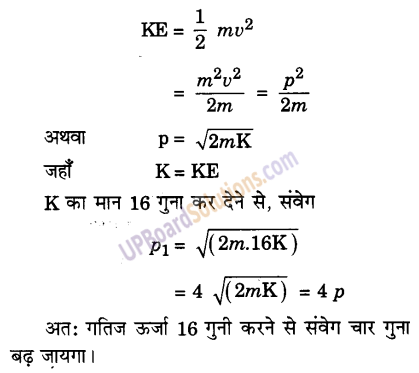
प्रश्न 16.
यांत्रिक ऊर्जा के संरक्षण के आधार पर सिद्ध कीजिए कि भूमि से ऊँचाई h से स्वतन्त्रतापूर्वक गिरने वाले पिण्ड का भूमि से टकराने का वेगः √2gh होता है।
उत्तर-
माना m द्रव्यमान की वस्तु h मीटर ऊँचाई पर स्थित है और विरामावस्था में है ऐसी दशा में उसकी स्थितिज ऊर्जा U = mgh
तथा गतिज ऊर्जा = [latex]\frac { 1 }{ 2 }[/latex] mu² = [latex]\frac { 1 }{ 2 }[/latex] m x 0 चूँकि u = 0
संपूर्ण यांत्रिक ऊर्जा E = K + U = 0 + mgh
यदि वायु के घर्षण द्वारा ऊर्जा का क्षय शून्य हो, तो पृथ्वी पर पहुँचते समय पृथ्वी से ऊँचाई = 0
U = mg x 0 = 0
और वेग यदि v मान लें तो वस्तु की गतिज ऊर्जा
K = [latex]\frac { 1 }{ 2 }[/latex] mv²
सम्पूर्ण यांत्रिक ऊर्जा, E = [latex]\frac { 1 }{ 2 }[/latex] mv² + 0
यांत्रिक ऊर्जा के संरक्षण के नियमानुसार, वस्तु की सम्पूर्ण यांत्रिक ऊर्जा प्रारम्भिक अवस्था से गिरते समय = वस्तु की सम्पूर्ण यांत्रिक ऊर्जा पृथ्वी पर पहुँचते समय
mgh = [latex]\frac { 1 }{ 2 }[/latex] mv²
v² = 2gh
v = √2gh [दोनों पक्षों को वर्गमूल लेने पर]
प्रश्न 17.
दो पिण्डों के द्रव्यमान m1 तथा m2 हैं तथा उनके संवेग समान हैं। यदि उनकी गतिज ऊर्जा क्रमशः E1 एवं E2 हो तो E1 : E2 कितना होगा?


प्रश्न 18.
एक पिण्ड पर बल लगाकर उसे विस्थापित किया जाता है। समझाइए
(i) पिण्ड पर किस दिशा में बल लगाने पर अधिकतम कार्य होगा?
(ii) पिण्ड पर किस दिशा में बल लगाने पर कार्य शून्ये होगा?
उत्तर-
(i) पिण्ड पर बल विस्थापन की दिशा में लगे तो कार्य अधिकतम होगा।
(ii) पिण्ड पर बल विस्थापन के लम्बवत् लगे तो कार्य शून्य होगा।
दीर्घ उत्तरीय प्रश्न
प्रश्न 1.
कार्य’ से क्या तात्पर्य है? इसे किस प्रकार नापा जाता है? आवश्यक सूत्र का निगमन कीजिए तथा कार्य का S.I. मात्र प्राप्त कीजिए।
उत्तर-
कार्य की परिभाषा (Definition of work) – सामान्य भाषा में कार्य का अर्थ किसी क्रिया के सम्पादन से होता है। जब कोई व्यक्ति खेत में हल चलाता है, चक्की से आटा पीसता है, लकड़ी चीरता है या ढेकली से खेत में पानी देता है, पुस्तक पढ़ता है या उसका मनन करता है, तो सामान्य भाषा में यह कहा जाता है कि व्यक्ति कार्य कर रहा है, परन्तु भौतिकी में कार्य का विशेष अर्थ है जो निम्नवत् है-
बल लगाकर किसी वस्तु को बल की (UPBoardSolutions.com) दिशा में । विस्थापित करने की क्रिया को ही कार्य कहते हैं। अर्थात् कार्य होने के लिए (i) बल तथा (ii) बल की दिशा । में विस्थापन दोनों आवश्यक हैं। यदि बल लगाने से वस्तु में विस्थापन उत्पन्न न हो या विस्थापन तो उत्पन्न हो परन्तु बल की दिशा में विस्थापन न हो, तो भौतिकी में यही कहा जायेगा कि कार्य नहीं हो रहा है।
कार्य की माप (Measurement of work) – स्पष्ट है कि यदि विभिन्न द्रव्यमान की वस्तुयें मेज पर पड़ी हों और उनमें से प्रत्येक को एक निश्चित ऊँचाई तक उठाना हो तो इस निश्चित विस्थापन को उत्पन्न करने के लिए उन पर लगाये गये बल का मान वस्तुओं के द्रव्यमान के अनुक्रमानुपाती होगा तथा जिस वस्तु को विस्थापित करने में अधिक बल लगाना पड़ेगा उस वस्तु पर किया गया कार्य भी उसी अनुपात में अधिक होगा।
अतः किसी वस्तु को एक निश्चित दूरी तक विस्थापित करने में किया गया कार्य वस्तु पर लगाये गये बल के अनुक्रमानुपाती होता है।
कार्य (W) ∝ बल (F) …(i)
अब यदि एक ही वस्तु को बल लगाकर विस्थापित किया जाता हो तो जितना अधिक विस्थापन होगा उसी अनुपात में किया गया कार्य भी अधिक होगा। पानी से भरी एक बाल्टी को जितनी अधिक ऊँचाई पर ऊपर ले जाना होगा उतना ही अधिक कार्य बाल्टी पर करना होगा।
अत: समान बल लगाकर किसी वस्तु को विस्थापित करने में किया गया कार्य विस्थापन के अनुक्रमानुपाती होगा।
कार्य (W) ∝ विस्थापन (d) …(ii)
अतः समीकरण (i) एवं (ii) से
कार्य (W) ∝ F (बल) x d (विस्थापन) …(iii)
W = K.F.d (जहाँ K एक समानुपाती स्थिरांक है।)
यदि कार्य का मात्रक इस प्रकार चुना जाय कि एकांक बल लगाने पर एकांक विस्थापन होने से कार्य भी एकांक हो अर्थात्
जब F = 1 तथा d = 1 तो W = 1
तब उपर्युक्त समीकरण (iii) से,
W = K.F.d या,
1 = K.1.1.
या, K = 1
अतः W = F x d.
अर्थात् कार्य = बल x बल की दिशा में विस्थापन
कार्य का मात्रक (Unit of Work) :
कार्य = बले x विस्थापन
कार्य को मात्रक = बल को मात्रक x विस्थापन का मात्रक
S.I. पद्धति में बल का मात्रक न्यूटन तथा विस्थापन का मात्रक मीटर है।
अतः कार्य का मात्रक = 1 न्यूटन x मीटर = 1 न्यूटन-मीटर।
S.I. पद्धति में कार्य के मात्रक न्यूटन-मीटर को जूल (joule) कहते हैं। जूल को संकेताक्षर J से प्रदर्शित करते है।
अतः 1 जूल का कार्य उस समय होगा जब एक न्यूटन का बल लगाकर वस्तु को बल की दिशा में 1 मीटर विस्थापित किया जाता है।

प्रश्न 2.
ऊर्जा’ का क्या अर्थ है? ऊर्जा तथा कार्य में सम्बन्ध स्पष्ट कीजिए।
उत्तर-
ऊर्जा – प्रतिदिन की बोलचाल की भाषा में हम सभी लोग ऊर्जा शब्द का प्रयोग करते हैं और उसके अर्थ को समझते हैं। दिनभर एक मजदूर शारीरिक कार्य करता है और शाम को थक जाने पर उसकी ऊर्जा कम हो जाती है। जिसको वह आराम करके तथा भोजन करके पुनः प्राप्त कर लेता है। अक्सर हम कहते हैं कि एक गिलास सन्तरे या गन्ने के रस में बड़ी ऊर्जा है। बीमार पड़ जाने पर टॉनिकों का प्रयोग करके ऊर्जा प्राप्त की जाती है। इस प्रकार भोजन करने, फलों के रस या टॉनिकों को लेने से हमें ऊर्जा प्राप्त होती है, जिससे हमें पुनः काम करने की क्षमता प्राप्त हो जाती है। इसी प्रकार कोयला, पेट्रोल, लकड़ी आदि अनेक इस प्रकार के ईंधन हैं। जिनसे मशीनों को कार्य करने की क्षमता प्राप्त होती है। अत: ऊर्जा एक ऐसा कारक (factor) है जो कार्य करने के लिए आवश्यक है।
जब किसी वस्तु में कार्य करने की क्षमता होती है। तो कहा जाता है कि वस्तु में ऊर्जा है।
ऊर्जा की कोई मौलिक परिभाषा नहीं दी (UPBoardSolutions.com) जा सकती। केवल यही कहा जा सकता है कि जिस कारण से किसी वस्तु में कार्य करने की क्षमता रहती है उसे ऊर्जा कहते हैं।
उदाहरणतः गिरते हुए हथौड़े, चलती हुई बन्दूक की गोली, उच्च दाब पर अथवा तेज बहती हुई वायु, ऊँचाई पर रखा अथवा तेज गति से बहते झरने का जल, ऊष्मा इंजन में जलवाष्प, विद्युत सेल आदि ऐसी वस्तुयें हैं जो कार्य कर सकती हैं अर्थात् वस्तुओं पर बल लगाकर उनका विस्थापन कर सकती हैं। अतः इनमें ऊर्जा है। स्पष्ट है कि ऊर्जा का मात्रक वही होगा जो कार्य का मात्रक है तथा कार्य की भाँति यह भी एक अदिश (Scalar) राशि है।
कार्य तथा ऊर्जा स्थानान्तरण (Work and Energy Transformation)-
हम जानते हैं कि बल लगाने में सदा दो वस्तुयें भाग लेती हैं- एक, जो बल लगा रही है तथा दूसरी, जिस पर बल लग रहा है जब किसी पत्थर के टुकड़े को हाथ से पकड़कर ऊपर उठाते हैं तो पत्थर पर बल हाथ द्वारा लगाया जा रहा है। पत्थर को उठाने का कार्य हाथ द्वारा किया गया है इस क्रिया में कार्य करने वाली वस्तु (हाथ) की ऊर्जा व्यय हुई और पत्थर, जिस पर कार्य किया गया उसको ऊर्जा प्राप्त हुई और उसकी ऊर्जा में वृद्धि हुई।
इसी प्रकार हॉकी का खिलाड़ी जब रुकी बाल (UPBoardSolutions.com) को स्टिक से हिट लगाकर आगे फेंकता है तो स्टिक द्वारा गेंद पर बल लगाया जाता है और स्टिक द्वारा गेंद पर कार्य किया जाता है जिससे गेंद की ऊर्जा में वृद्धि हो जाती है। तथा हिट लगाने वाले की ऊर्जा का व्यय होता है। इस प्रकार ऊर्जा स्टिक से गेंद में स्थानान्तरित हो गयी। स्पष्ट है कि कार्य होने की क्रिया में ऊर्जा स्थानान्तरण होता है।
कार्य तथा ऊर्जा में सम्बन्ध – जब एक वस्तु दूसरी पर कार्य करती है तो कार्य करने वाली वस्तु की ऊर्जा को व्यय होता है तथा जिस पर कार्य किया जाता है उसकी ऊर्जा बढ़ जाती है। निकाय की सम्पूर्ण ऊर्जा में कोई परिवर्तन नहीं होता। एक की जितनी ऊर्जा व्यय होती है। उतनी ही ऊर्जा की वृद्धि दूसरे की हो जाती है। ऊर्जा-स्थानान्तरण की माप किये गये कार्य से की जा सकती है।
स्थानान्तरित ऊर्जा = किया गया कार्य
प्रश्न 3.
गतिज ऊर्जा की परिभाषा लिखिए तथा किसी गतिमानवस्तुकी गतिज ऊर्जा का सूत्रनिगमित कीजिए।
अथवा
किसी पिण्ड का द्रव्यमान m एवं इसका वेग v है। सिद्ध कीजिए कि उसकी गतिज ऊर्जा [latex]\frac { 1 }{ 2 }[/latex] mv² होगी।
उत्तर-
गतिज ऊर्जा (Kinetic Energy) – किसी वस्तु में उसकी गति के कारण कार्य करने की जो क्षमता होती है उसे उस वस्तु की गतिज ऊर्जा कहते है।
उदाहरणार्थ – पैडल चलाना बंद करने पर भी साइकिल, उस पर लगने वाले घर्षण बल के विरुद्ध कुछ दूरी तय कर सकती है। इस क्रिया में साइकिल घर्षण बल के विरुद्ध कार्य करती है। उसकी यह गतिज ऊर्जा उसके द्वारा किये गये इस कार्य के बराबर होगी।
गतिज ऊर्जा का सूत्र (Formula of Kinetic Energy) – माना कि m द्रव्यमान की कोई वस्तु v वेग से गतिशील है और एक मंदक बल F लगाने पर वह s दूरी चलकर विरामावस्था में आ जाती है। इन क्रिया में वस्तु द्वारा जितना कार्य किया जायगा वही उसकी गतिज ऊर्जा होगी। चूँकि F बल के विरुद्ध s दूरी चलने में किया गया कार्य F.s होता है अतः उसकी गतिज (UPBoardSolutions.com) ऊर्जा का मान F.s होगा।
यदि मंदक बल F के कारण वस्तु में उत्पन्न मंदन a हो तो गति के तृतीय समीकरण के लिए वस्तु का प्रारंभिक वेग v, अंतिम वेग शून्य, त्वरण -q तथा चली गयी दूरी s है।
अतः

Potential Energy Calculator is online tool that finds the gravitational potential energy of an object using the potential energy formula.
प्रश्न 4.
स्थितिज ऊर्जा से क्या अर्थ है? स्थितिज ऊर्जा के विभिन्न स्वरूपों का संक्षिप्त विवरण दीजिए।
उत्तर-
स्थितिज ऊर्जा (Potential Energy) – किसी वस्तु में उसकी विशेष अवस्था अथवा स्थिति के करण, वस्तु में कार्य करने की जो क्षमता होती है उसे वस्तु की स्थितिज ऊर्जा कहते हैं। इस ऊर्जा की माप उस कार्य से की जायगी जो वह वस्तु अपनी अवस्था विशेष से प्रारम्भिक सामान्य अवस्था में आने में कर सकती है।
स्थितिज ऊर्जा सापेक्ष रूप से ही नापी जाती है। वस्तु की प्रारम्भिक अवस्था कुछ भी मानी जा सकती है और स्थितिज ऊर्जा की माप उस अवस्था के सापेक्ष नापी जायेगी। यह आवश्यक नहीं है कि तनावरहित स्थिति को ही प्रारम्भिक स्थिति माना जाय। संपीडित अथवा तनी हुई अवस्था (UPBoardSolutions.com) को भी प्रारम्भिक स्थिति मानकर अन्य अवस्थाओं में पूर्व अवस्था के सापेक्ष स्थितिज ऊर्जा की माप की जा सकती है। भिन्न-भिन्न प्रारम्भिक अवस्थाओं के लिए एक विशेष अवस्था की स्थितिज ऊर्जा भिन्न-भिन्न होगी।
स्थितिज ऊर्जा के विभिन्न स्वरूप (Different Forms of Potential Energy)-
(i) प्रत्यास्थ स्थितिज ऊर्जा (Elastic Potential Energy) – किसी संपीडित अथवा तनी हुई स्प्रिंग, तनी हुई कमान, खिंची हुई रबर की पट्टी, मुड़ी हुई धातु की छड़, संपीडित गैस आदि में उनकी प्रत्यास्थता (Elasticity) के गुण के कारण ऐसे बल उत्पन्न हो जाते हैं जो उन्हें सामान्य प्रारम्भिक अवस्था में लाने का प्रयास करते हैं। इन बलों को अन्य वस्तुओं पर आरोपित कराके कार्य किया जा सकता है।
अतः प्रत्यास्थ बलों के कारण वस्तुओं में निहित ऊर्जा को प्रत्यास्थ स्थितिज ऊर्जा कहते हैं।
(ii) गुरुत्वीय स्थितिज ऊर्जा (Gravitational Potential Energy) – जैसे ही किसी m द्रव्यमान का पिण्ड पृथ्वी की सतह से v वेग से ऊपर उठता है, गुरुत्वाकर्षण बल mg पिण्ड पर नीचे की ओर गति की दिशा के विरुद्ध, कार्य करने लगता है और इस बल के विरुद्ध वस्तु जब ऊपर उठती है तो उसका वेग घटने लगता है। जब इसका वेग v से घटकर v1 हो जाता है तो गतिज ऊर्जा [latex]\frac { 1 }{ 2 }[/latex] mv² से घटकर [latex]\frac { 1 }{ 2 }[/latex] mv1² हो जाती है। इस गतिज ऊर्जा का परिवर्तन स्थितिज ऊर्जा के रूप में होता है जो पिण्ड में एकत्र हो जाती है।h ऊँचाई पर पहुँचकर जब वस्तु का वेग शून्य हो जाता है और गतिज ऊर्जा शून्य हो जाती है तो इस क्रिया में सम्पूर्ण गतिज ऊर्जा को रूपान्तरण पिण्ड में स्थितिज ऊर्जा के रूप में (UPBoardSolutions.com) हो जाता है। इस क्रिया में पिण्ड में स्थितिज ऊर्जा उस पर लगने वाले गुरुत्वाकर्षण बल के विरुद्ध कार्य करने के कारण उत्पन्न हुई अत: इस ऊर्जा को गुरुत्वीय स्थितिज ऊर्जा कहते हैं।
किसी स्थिति में वस्तु की गुरुत्वीय स्थितिज ऊर्जा उस कार्य से मापी जाती है जो उस वस्तु को किसी प्रारम्भिक स्थिति से उस स्थिति विशेष में गुरुत्वाकर्षण बल के विरुद्ध लाने में करना पड़ता है।
यदि पृथ्वी के तल को प्रारम्भिक स्थिति मान लिया। जाय (अर्थात् इस स्थिति में स्थितिज ऊर्जा शुन्य है) तो m द्रव्यमान के पिण्ड को x ऊँचाई तक गुरुत्वाकर्षण बल के विरुद्ध विस्थापित करने में पिण्ड पर किया गया कार्य = गुरुत्वीय बल x विस्थापन = (mg) x (x) = mgx
अब जब पिण्ड x ऊँचाई पर पहुँच जाता है तो पृथ्वी तल के सापेक्ष पिण्ड की गुरुत्वीय स्थितिज ऊर्जा mgx होगी तथा h ऊँचाई पर पिण्ड की गुरुत्वीय स्थितिज ऊर्जा mgh होगी।
गुरुत्वीय क्षेत्र में कोई वस्तु पृथ्वी तल से जितनी अधिक ऊँचाई पर स्थित होगी उतनी ही अधिक उसकी गुरुत्वीय स्थितिज ऊर्जा होगी, क्योंकि अधिक ऊँचाई से गिरने वाली वस्तुओं द्वारा अधिक कार्य किया जा सकता है।
(iii) वैद्युत स्थितिज ऊर्जा (Electrical Potential Energy) – जिस प्रकार पृथ्वी के गृरुत्वीय क्षेत्र में रखे किसी पिण्ड पर लगने वाले गुरुत्वाकर्षण बल के। कारण उसमें गुरुत्वीय स्थितिज ऊर्जा का समावेश हो जाता है, उसी प्रकार विद्युत क्षेत्र में यदि कोई आवेशित वस्तु रखी हो तो उस पर लगने वाले वैद्युत बलों के कारण वस्तुयें विस्थापित हो सकती हैं और उनमें कार्य करने की क्षमता का समावेश हो जाता है।
यह ऊर्जा वस्तु में विशेष अवस्था (वैद्युत क्षेत्र में स्थित होने) के कारण है
अतः इस ऊर्जा को वैद्युत स्थितिज ऊर्जा कहते हैं।
(iv) चुम्बकीय स्थितिज ऊर्जा (Magnetic Potential Energy) – चुम्बकीय क्षेत्र में स्थित किसी गतिशील आवेश या धारावाही चालक पर चुम्बकीय बलों के कारण कार्य करने की जो क्षमता उत्पन्न होती है उसे चुम्बकीय स्थितिज ऊर्जा कहा जाता है।
(v) रासायनिक ऊर्जा (Chemical Energy) – पदार्थ में उसकी विशेष परमाणविक संरचना के कारण जो स्थितिज ऊर्जा निहित होती है उसे रासायनिक ऊर्जा कहते हैं। रासायनिक क्रियाओं में इस ऊर्जा का रूपान्तरण अन्य स्वरूप (ऊष्मा, प्रकाश, वैद्युत-ऊर्जा आदि) में होता है।
(vi) नाभिकीय ऊर्जा (Nuclear Energy) – पदार्थ के मूल कणों (प्रोटॉन तथा न्यूट्रॉन) के परमाणुओं के नाभिक में रहने की विशेष अवस्था के कारण नाभिक (UPBoardSolutions.com) में जो स्थितिज ऊर्जा निहित रहती है उसे नाभिकीय ऊर्जा कहते हैं। परमाणु-बम, हाइड्रोजन बम, सूर्य तथा अन्य नक्षत्रों (stars) में नाभिकीय ऊर्जा का रूपान्तरण ऊष्मा, प्रकाश, यांत्रिक ऊर्जा आदि में होता है।
(vii) द्रव्यमान ऊर्जा (Mass Energy) – विभिन्न प्रकार की नाभिकीय प्रक्रियाओं में पदार्थ के द्रव्यमान का कुछ अंश ऊर्जा में परिवर्तित हो जाता है अर्थात् द्रव्यमान भी ऊर्जा का ही एक स्वरूप है। इसे दव्यमान ऊर्जा (Mass Energy) कहते हैं।

प्रश्न 5.
ऊर्जा-संरक्षण’ का क्या अर्थ है? उदाहरण देकर समझाइए।
उत्तर-
ऊर्जा का संरक्षण (Conservation of Energy) – विज्ञान के अध्ययन के फलस्वरूप ऊर्जा सम्बन्धी एक बहुत ही महत्त्वपूर्ण तथा व्यापक सिद्धान्त का पता चलता है। वह सिद्धान्त यह है कि ऊर्जा का एक रूप से दूसरे रूप में केवल परिवर्तन ही किया जा सकता है, ऊर्जा न तो उत्पन्न की जा सकती है न ही नष्ट। इसे ऊर्जा के संरक्षण का सिद्धान्त (Principle of Conservation of Energy) कहते हैं। इसके परिणामस्वरूप विश्व की समस्त प्रकार की ऊर्जा का कुल परिमाण स्थिर (constant) रहता है। इसका (UPBoardSolutions.com) तात्पर्य यह है कि यदि किसी क्रिया में किसी प्रकार की कुछ ऊर्जा लुप्त हो जाती है तो उतनी ही ऊर्जा किसी दूसरे रूप में उत्पन्न हो जाती है।
ऊर्जा – संरक्षण के उदाहरण (Examples of Conservation of Energy)
उदाहरण-
1. जब कोई पिण्ड किसी ऊँचाई से गिर रहा होता है तो उसकी गुरुत्वीय स्थितिज ऊर्जा (U = mgh) का मान h के निरन्तर घटते जाने से कम होता जाता है जबकि पिण्ड का वेग v बढ़ता जाता है।
अतः पिण्ड की गतिज ऊर्जा [latex]\frac { 1 }{ 2 }[/latex] mv² बढ़ती जाती है। इस प्रकार पिण्ड की गुरुत्वीय स्थितिज ऊर्जा का रूपान्तरण गतिज ऊर्जा में होता रहता है परन्तु गणितीय विवेचना द्वारा निम्न प्रकार यह सिद्ध किया जा सकता है कि पिण्ड की प्रत्येक स्थिति में उसकी गतिज एवं स्थितिज ऊर्जा का योग अर्थात् उसकी सम्पूर्ण ऊर्जा नियत रहती है।
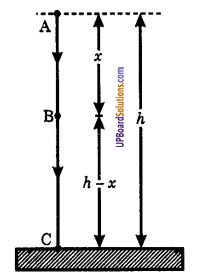
मान लीजिए m द्रव्यमान की एक वस्तु पृथ्वी तल से h ऊँचाई पर स्थित बिन्दु A पर विरामावस्था में है। क्योंकि A पर वस्तु का वेग शून्य है, इसलिए यहाँ इसकी गतिज ऊर्जा का मान शून्य होगा। अतः इस अवस्था में वस्तु की।
कुल ऊर्जा = गतिज ऊर्जा + स्थितिज ऊर्जा = 0 + mgh = mgh … (i)
अब मान लें वस्तु को उसकी प्रारम्भिक स्थिति से x दूरी नीचे बिन्दु B तक गिराया जाता है। गति के तीसरे समीकरण से B पर वस्तु में उत्पन्न वेग ७ निम्न समीकरण से दिया जायेगा-

उपर्युक्त समीकरण (i), (ii) व (iii) से स्पष्ट है कि तीनों स्थितियों में वस्तु की कुल ऊर्जा सदैव स्थिर mgh रहती है। जब वस्तु पृथ्वी से टकरा जाती है तो उसकी कुल ऊर्जा ऊष्मा, ध्वनि तथा प्रकाश में बदल जाती है।
इसी प्रकार ऊपर की ओर फेंके गये पिण्ड में भी गतिज ऊर्जा का रूपान्तरण स्थितिज ऊर्जा में होता जाता है तथा प्रत्येक स्थिति में दोनों का योग नियत रहता है।
2. सरल लोलक की दोलन क्रिया में भी गोलक की विभिन्न स्थितियों में इसकी गुरुत्वीय स्थितिज ऊर्जा गतिज ऊर्जा में तथा गतिज ऊर्जा स्थितिज ऊर्जा में रूपान्तरित होती रहती है। यदि घर्षण का प्रभाव नगण्य माना जाय तो प्रत्येक स्थिति में दोनों प्रकार की ऊर्जाओं का योग नियत रहता है। ऊर्जा संरक्षण के कारण आदर्श स्थिति (घर्षण की अनुपस्थिति) में यह निरन्तर गति करता रहेगा परन्तु व्यवहार में इसकी ऊर्जा निलम्बन आधार तथा गोलक व वायु के बीच घर्षण के विरुद्ध कार्य करने में धीरे-धीरे व्यय होती रहती है। यह व्यय हुई ऊर्जा ऊष्मा में रूपान्तरित होती रहती है जिससे दोलनों का आयाम धीरे-धीरे कम होता जाता है। यदि इस दशा में ऊष्मीय ऊर्जा को भी । गणना में ले लिया जाय तो गोलक की प्रत्येक स्थिति में स्थितिज, गतिज एवं ऊष्मीय ऊर्जा का योग नियत रहता है। यही ऊर्जा संरक्षण का नियम है।
3. स्प्रिंग (Spring) – चित्र के अनुसार एक स्प्रिंग से एक भार लटकाइए। जब भार चित्र
(क) की तरह उच्चतम बिन्दु पर होता है, तो उसमें केवल स्थितिज ऊर्जा होती है और स्प्रिंग में कोई ऊर्जा नहीं होती।

जब भार नीचे को लगता है, तो उसमें गति उत्पन्न होने के कारण गतिज ऊर्जा संचित होती है, किन्तु स्थितिज ऊर्जा में कमी होती है। इसके अतिरिक्त स्प्रिंग को खींचने के कारण उसमें स्थितिज ऊर्जा का संचय होता है। जब भार अपनी गतिशील अवस्था में होता है, तो उसकी प्रारम्भिक पूर्ण स्थितिज ऊर्जा, इसकी अपनी गतिज ऊर्जा एवं स्प्रिंग की स्थितिज ऊर्जा में परिणत हो जाती है। जब भार चित्र
(ख) की तरह निम्नतम बिन्दु पर होता है तो उसकी सम्पूर्ण ऊर्जा स्प्रिंग की स्थितिज ऊर्जा के रूप में परिवर्तित हो जाती है। परिकलन से ज्ञात होता है कि प्रत्येक स्थिति में कुल ऊर्जा का परिमाण नियत रहता है। स्पष्ट है कि इसमें ऊर्जा संरक्षण के नियम का पालन होता है।
प्रश्न 6.
ऊर्जा के विभिन्न स्रोतों का विवरण दीजिए।
उतर-
ऊर्जा के स्रोत (Sources of Energy) – ऊर्जा के प्रमुख स्रोत निम्नलिखित हैं-
1. ईंधन (Fuels) – लकड़ी, कोयला, किरोसीन, पेट्रोल, डीजल आदि को जलाकर ऊष्मा प्राप्त की जाती है, जिसका सीधे अथवा विद्युत-ऊर्जा में परिवर्तन करके उपयोग किया जाता है। वर्तमान समय में यह ऊर्जा का प्रयुक्त होने वाला स्रोत है।
2. जल से ऊर्जा (To Water Energy) – भाखड़ा-नांगल जैसे बाँधों (Dams) में पहले जल को ऊँचाई पर इकट्ठा किया जाता है। इस जल में स्थितिज ऊर्जा होती है। जब जल टरबाइन के पंखे की पंखुड़ियों पर गिरकर टकराता है तो टरबाइन का पहिया घूमने लगता है। इस क्रिया में जल की स्थितिज ऊर्जा पहिये की गतिज ऊर्जा में बदल जाती है। इस पहिये द्वारा एक डायनामो के आर्मेचर को घुमाते हैं जिससे विद्युत ऊर्जा प्राप्त होती है। आजकल विद्युत ऊर्जा प्राप्त करने का यह महत्त्वपूर्ण स्रोत है।
3. वायु से ऊर्जा (To Air Energy) – वायु की गतिज ऊर्जा से अनेक यांत्रिक कार्य किये जाते हैं, जैसे अनाज से भूसा अलग करना, समुद्र में पाल द्वारा नाव चलाना, पवन-चक्की द्वारा विद्युत उत्पादन आदि।
4. ईंधन, कोयला, पेट्रोल (Fuel, coal, Petrolium) – विभिन्न प्रकार के ईंधनों, जैसे कोयला, मिट्टी का तेल, गैस, पेट्रोल आदि में रासायनिक ऊर्जा होती है। विभिन्न युक्तियों का प्रयोग करके ऐसे इंजन तैयार किये गये हैं। जिनमें इन ईंधनों की रासायनिक ऊर्जा यांत्रिक ऊर्जा में बदली जाती है। इसी से मोटरकार, वायुयान आदि के इंजन चलाये जाते हैं।
5. नाभिकीय ऊर्जा (Nuclear Energy) – सन् 1939 में दो जर्मन वैज्ञानिकों हॉन तथा स्ट्रॉसमैन (Hahn and Strassman) ने यूरेनियम पर तीव्रगामी न्यूट्रॉनों की बमबारी की। इस बमबारी से यूरेनियम का नाभिक दो लगभग बराबर नाभिकों में टूट जाता है तथा कुछ द्रव्यमान की क्षति हो जाती है। यह द्रव्यमान क्षति आइन्सटीन के द्रव्यमाने-ऊर्जा सिद्धान्त के अनुसार ऊर्जा में परिवर्तित हो जाती है तथा अत्यधिक ऊर्जा मुक्त होती है।
उपर्युक्त अभिक्रिया में जो ऊर्जा मुक्त होती है (UPBoardSolutions.com) उसे नाभिकीय ऊर्जा कहते हैं तथा यह क्रिया नाभिकीय विखण्डन कहलाती है। उस ऊर्जा को उत्पन्न करने के लिए नाभिकीय रिएक्टर (Nuclear Reactors) बनाये। गये हैं। मुम्बई के निकट ट्राम्बे में भाषा अनुसंधान केन्द्र में कई रिएक्टर-अप्सरा, साइरस और जरलीना कार्य कर रहे हैं। इनमें से अप्सरा सन् अगस्त 1956 से तथा जरलीना सन् 1961 से कार्य कर रहा है। इन रिएक्टरों से वैद्युत-ऊर्जा का उत्पादन किया जाता है।
हमारे देश में विभिन्न स्थानों जैसे तारापुर (महाराष्ट्र), कोटा (राजस्थान), कलपक्कम (तमिलनाडु) तथा नरोरा (उत्तर प्रदेश) में ऐसे वैद्युत उत्पादक गृह हैं जिनमें नाभिकीय रिएक्टरों से प्राप्त नाभिकीय ऊर्जा से वैद्युत ऊर्जा का उत्पादन किया जाता है।
6. अवशिष्ट जैव पदार्थ – हम दैनिक जीवन में बहुत-से कार्बनिक पदार्थों को बेकार समझकर फेंक देते हैं। अब ऐसे पदार्थ ऊर्जा के स्रोत के रूप में प्रयोग में लाये जा रहे हैं। उदाहरणार्थ : सड़ी-गली वनस्पतियाँ, गोबर आदि। इनको इकट्ठा करके किसी बन्द गड्डे में सड़ने दिया जाता है। इनसे एक प्रकार की गैस निकलती है जिसे मेथेन (CH4) कहते हैं। यह एक ज्वलनशील गैस है। जिसका प्रयोग आजकल ईंधन की जगह किया जा रहा है। गोबर गैस भी इसी प्रकार का उदाहरण है।

प्रश्न 7.
सूर्य को ऊर्जा का मूल स्रोत क्यों कहते हैं? सूर्य की प्राप्त ऊष्मा तथा प्रकाश, किस प्रकार के ऊर्जा रूपान्तरण से प्राप्त होते हैं?
उत्तर-
ऊर्जा का मूल स्रोत : सूर्य-वास्तव में सभी प्रकार की ऊर्जाओं का मूल स्रोत सूर्य ही है। मनुष्य ने पृथ्वी पर जो भी ऊर्जा का स्रोत बनाया है अथवा खोजा है। उन सब में सूर्य की ऊर्जा का ही रूपान्तरण होता है। सूर्य से ऊर्जा प्राप्त कर नये पेड़-पौधे बढ़ते हैं जिससे लकड़ी प्राप्त होती है। प्राचीन काल में पेड़-पौधों के पृथ्वी के अन्दर दब जाने से पृथ्वी के अन्दर अत्यधिक दाब के कारण ये पत्थर के कोयले, पेट्रोल आदि में परिवर्तित हो जाते हैं। इनसे हम ऊर्जा प्राप्त करते हैं। समुद्र का जल सूर्य से ऊष्मा लेकर वाष्प में परिवर्तित हो (UPBoardSolutions.com) वायुमण्डल में चला जाता है तथा वर्षा होती है। वर्षा के जल से, बड़े-बड़े बाँध बनाकर वैद्युत ऊर्जा उत्पन्न की जाती है। अतः हमारी पृथ्वी पर समस्त ऊर्जा स्रोतों का मूल स्रोत सूर्य से प्राप्त ऊर्जा ही है जो सौर ऊर्जा कहलाती है।
सूर्य में ऊर्जा की उत्पत्ति पदार्थ के द्रव्यमान अथवा द्रव्यमान-ऊर्जा के रूपान्तरण से होती है। सूर्य में हाइड्रोजन का विशाल भण्डार है। सूर्य में ऊर्जा-रूपान्तरण की क्रिया में चार-चार हाइड्रोजन नाभिक परस्पर संयोग करके एक-एक हीलियम नाभिक बनाते रहते हैं। इस क्रिया में पदार्थ (नाभिकों) का कुछ द्रव्यमान, ऊष्मा, प्रकाश तथा अन्य स्वरूपों में रूपान्तरित हो जाता है। यही ऊर्जा सूर्य में प्रसारित होती है। द्रव्यमान से ऊर्जा में रूपान्तरण की इस प्रक्रिया को नाभिकीय संलयन (Nuclear Fusion) कहते हैं।
द्रव्यमान एवं ऊर्जा के पारस्परिक रूपान्तरण की परिकल्पना सर्वप्रथम वैज्ञानिक आइन्सटीन ने सन् 1905 में की थी। सापेक्षता सिद्धान्त (Theory of Relativity) के अनुसार उन्होंने गणितीय विवेचना द्वारा, द्रव्यमान तथा ऊर्जा के पारस्परिक सम्बन्ध को निम्नलिखित समीकरण द्वारा व्यक्त किया। इसके अनुसार द्रव्यमान m के रूपान्तरण से प्राप्त ऊर्जा
E = mc²
जबकि c = 3 x 108 मीटर-सेकण्ड-1, निर्वात में प्रकाश की चाल है।
उदाहरण : 1 किलोग्राम से प्राप्त ऊर्जा का मान E = 1 किग्रा (3 x 108 मीटर-सेकण्ड-1)2 = 9 x 1016 जूल।
प्रश्न 8.
यांत्रिक ऊर्जा संरक्षण का नियम लिखिए। सिद्ध कीजिए कि स्वतन्त्रतापूर्वक गिरते हुए किसी भी पिण्ड में गतिज ऊर्जा तथा स्थितिज ऊर्जा का योग सदैव नियत रहता है।
उत्तर-
यांत्रिक ऊर्जा का संरक्षण नियम – यदि किसी वस्तु से ऊष्मा अथवा विकिरणों के रूप में ऊर्जा की हानि न हो, तो वस्तु की यांत्रिक ऊर्जा (गतिज ऊर्जा + स्थितिज ऊर्जा) अचर बनी रहती है।
नोट – शेष उत्तर हेतु दीर्घ उत्तरीय प्रश्न संख्या 5 के उत्तर में ऊर्जा संरक्षण का नियम में दिये गये उदाहरण (1) को देखिए।
आंकिक प्रश्न
प्रश्न 1.
2 किग्रा की एक पुस्तक 1 मीटर ऊँची मेज पर रखी है। पुस्तक की स्थितिज ऊर्जा की गणना कीजिए। (g = 9.8 मी.से-2)
हल :
द्रव्यमान m = 2 किग्रा
ऊँचाई (h) = 1 मी
स्थितिज ऊर्जा (P.E.) = mgh = 2 x 9.8 x 1 = 19.6 जूल।
प्रश्न 2.
एक पिण्ड पर 20 न्यूटन का बल लगता है। यदि बल की क्रिया-रेखा विस्थापन की दिशा में 45° का कोण बनाता है। तो पिण्ड को 4 मीटर विस्थापित करने में किये गये कार्य का मान ज्ञात कीजिए।
हल :
कार्य (W) = F x d.cosθ [cos45° = [latex]\frac { 1 }{ \surd 2 }[/latex]]
= 20 x 4 x cos45°
= 80 x [latex]\frac { 1 }{ \surd 2 }[/latex]
= 40√2 जूल
= 40 x 1.4142 [√2 = 1.4142]
= 56.57 जूल।

प्रश्न 3.
एक कुली 40 किग्रा का बोझ लेकर क्षैतिज प्लेटफॉर्म पर 20 मीटर की दूरी चलता है। उसके द्वारा गुरुत्वाकर्षण के विरुद्ध कितना कार्य किया गया?
हल :
शून्य, क्योंकि W = Fd.cos θ, F व d लम्बवत् हैं।
= mgd cos 90° = 40 x 9.8 x 20 x cos 90° [cos 90°= 0]
= 40 x 9.8 x 20 x 0 = 0
प्रश्न 4.
एक मशीन 20 सेकण्ड में 150 जूल कार्य करती है। मशीन की सामर्थ्य क्या है?

प्रश्न 5.
एक पम्प की सामर्थ्य 7.5 किलोवाट है। वह प्रति मिनट अधिक से अधिक कितना पानी 25 मीटर ऊपर उठा सकता है? (g = 10 मी.सेकण्ड-2)
हल :
दिया हैसामर्थ्य 7.5 किलोवाट = 7500 वाट
कार्य = सामर्थ्य x समय
बल x विस्थापन = सामर्थ्य x समय
द्रव्यमान x त्वरण x विस्थापन = सामर्थ्य x समय

प्रश्न 6.
10 अश्व-सामर्थ्य की मोटर द्वारा 7.46 मीटर गहरे कुएँ से प्रति सेकण्ड कितने किलोग्राम पानी खींचा जा सकता है? (g = 10 मी.सेकण्ड-2)


प्रश्न 7.
एक इंजन की सामर्थ्य 20 किलोवाट है। इसके द्वारा 100 किग्रा. के पिण्ड को 50 मीटर ऊँचाई तक उठाने में कितना समय लगेगा? ( g = 10 मी-सेकण्ड-2)
हल :
सामर्थ्य = 20 किलोवाट = 20 x 103 वाट;
द्रव्यमान = 100 किग्रा; विस्थापन = 50 मीटर।
सामर्थ्य = कार्य/समय

प्रश्न 8.
5 किग्रा-भार के एक पत्थर के टुकड़े को 10 मीटर ऊँचाई से गिराया जाता है। पृथ्वी से टकराते समय उसकी गतिज ऊर्जा की गणना कीजिए। पृथ्वी का गुरुत्वीय त्वरण 10 मी.से है।
हल :
पत्थर का द्रव्यमान (m) = 5 किग्रा
ऊँचाई (h) = 10 मीटर
g = 10 मी.से-2 (दिया है)
स्थितिज ऊर्जा = mgh = 5 x 10 x 10 = 500 जूल।
स्थितिज ऊर्जा ही गतिज ऊर्जा में परिवर्तित हो जाएगी।

प्रश्न 9.
10 किलोवाट सामर्थ्य वाले एक इंजन द्वारा 80 मीटर की ऊँचाई पर स्थित एक पानी की टंकी जिसकी क्षमता 50 किलोलीटर है, को भरने में लगने वाले समय की गणना कीजिए। पृथ्वी का गुरुत्वीय त्वरण 10 मीटर-सेकण्ड-2 है।
हल :
टंकी को भरने में किया गया कार्य = mgh = 50 x 1000 x 10 x 80 जूल
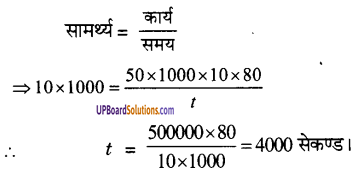
प्रश्न 10.
2 किग्रा द्रव्यमान का एक पिण्ड पृथ्वी से 10000 सेमी की ऊँचाई से गुरुत्वीय त्वरण (g) के अन्तर्गत स्वतंत्रतापूर्वक नीचे गिरता है। पृथ्वी पर पहुँचने पर इसका वेग तथा कुल ऊर्जा ज्ञात कीजिए। (g = 10 मीटर.से-2)
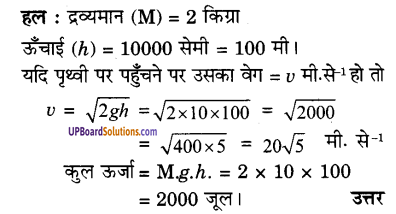
प्रश्न 11.
10 किग्रा की एक ट्रॉली को एक स्प्रिंग से इतना सटाकर रखते हैं कि स्प्रिंग दबी रहे। ट्रॉली को छोड़ने पर स्प्रिंग के धक्के से ट्रॉली 4 मीटर-सेकण्ड-1 के वेग से चलना प्रारम्भ कर देती है। दबी अवस्था में स्प्रिंग की स्थितिज ऊर्जा कितनी थी?
हल :
स्प्रिंग खुलने पर ट्रॉली को गतिज ऊर्जा प्रदान करता है जो उसकी स्थितिज ऊर्जा के बराबर होती है।
ट्रॉली की गतिज ऊर्जा = [latex]\frac { 1 }{ 2 }[/latex] mv²
[latex]\frac { 1 }{ 2 }[/latex] x 10 किग्रा x (4 मीटर.सेकण्ड-1)2
= 80 किग्रा मीटर .सेकण्ड-2 = 80 जूल
अत: स्प्रिंग की स्थितिज ऊर्जा = 80 जूल।
प्रश्न 12.
1 ग्राम द्रव्यमान को ऊर्जा में बदल देने पर कितनी ऊर्जा प्राप्त होगी?

प्रश्न 13.
18 मीटर ऊँची तथा 10 किलोलीटर क्षमता की पानी की टंकी को आधे घण्टे में भरने के लिए किस सामर्थ्य की मोटर लगानी पड़ेगी?

प्रश्न 14.
एक पम्प प्रति सेकण्ड 100 किग्रा जल 5 मीटर की ऊँचाई तक उठाता है। पम्प की सामर्थ्य की गणना कीजिए। (g = 10 मीटर-सेकण्ड-2)

प्रश्न 15.
एक खिलाड़ी पोल वाल्ट के खेल में 5.0 मीटर ऊँचा कूदना चाहता है। यदि ऊपर उठने के लिए आवश्यक ऊर्जा उसकी गति से प्राप्त हो तो उसे किस वेग से दौड़ना चाहिए?(g = 10 मीटर-सेकण्ड-2)
हल :
खिलाड़ी को इतने वेग से दौड़ना चाहिए कि कूदने से पूर्व उसकी गतिज ऊर्जा उसकी उच्चतम बिन्दु पर स्थितिज ऊर्जा के बराबर हो|
गतिज ऊर्जा = स्थितिज ऊर्जा
[latex]\frac { 1 }{ 2 }[/latex] mv² = mgh
अथवा v² = 2gh = 2 x 10 x 5 = 10 x 10
v = 10 मीटर-सेकण्ड-1
प्रश्न 16.
10 किग्रा दव्यमान के एक पत्थर को ऊर्ध्वाधर फेंका जाता है एवं वह पृथ्वी की सतह से 10 मीटर ऊँचाई तक पहुँचती है। फेंके जाते समय उसकी प्रारम्भिक गतिज ऊर्जा की गणना कीजिए। पृथ्वी का गुरुत्वीय त्वरण 10 मीटर-से-1 है।
हल :
द्रव्यमाने m = 5 किग्रा
पृथ्वी की सतह से ऊँचाई h = 10 मीटर
गुरुत्वीय त्वरण g = 10 मी.से
स्थितिज ऊर्जा = mgh = 10 x 10 x 10 = 1000 जूल
यही ऊर्जा प्रारम्भिक गतिज ऊर्जा थी।
प्रश्न 17.
500 किग्रा द्रव्यमान की मोटर कार की चाल 20 मी.से-1 से बढ़ाकर 40 मी.से-1 करने में इंजन को कितना कार्य करना पड़ेगा? यदि यह कार्य 15 सेकण्ड में हो जाय तो इंजन की क्षमता का मान अश्व-शक्ति में कितना होगा?

प्रश्न 18.
एकं पम्प की सामर्थ्य 5 किलोवाट है। यह 100 मीटर ऊँचाई पर स्थित टंकी में प्रति मिनट कितना जल चढ़ा सकता है? (g = 10 मी-से-2)
हल :
पम्प की सामर्थ्य = 5 किलोवाट = 5000 वाट
माना पम्प W किग्रा पानी टंकी में प्रति मिनट चढ़ा सकता है,
W किग्रा पानी 100 मी ऊपर चढ़ाने में किया गया
कार्य = Wgh = W x 10 x 100
पम्प की सामर्थ्य के अनुसार प्रति मिनट उसके द्वारा किया गया कार्य = 5000 x 60 जूल।
W x 10 x 100 = 5000 x 60
W = [latex]\frac { 5000 x 60 }{ 10×100 }[/latex] = 300 किग्रा।

प्रश्न 19.
2 किग्रा द्रव्यमान का पिण्ड 20 मीटर की ऊँचाई से विरामावस्था से भूमि पर गिरने में 20 मीटर-सेकण्ड-1 की चाल से भूमि पर पहुँचता है। गणना द्वारा सिद्ध कीजिए कि यह आँकड़े यान्त्रिक ऊर्जा के संरक्षण की पुष्टि करते हैं। (g = 10 मी.से-2)
हल :
20 मीटर की ऊँचाई पर पिण्ड की स्थितिज ऊर्जा = mgh = 2 x 10 x 20 = 400 जूल।
तथा गतिज ऊर्जा = शून्य अतः कुल ऊर्जा = 400 जूल + 0 जूल = 400 जूल
पृथ्वी तल पर पहुँचने से स्थितिज ऊर्जा = शून्य तथा गतिज ऊर्जा = [latex]\frac { 1 }{ 2 }[/latex] mv²
= [latex]\frac { 1 }{ 2 }[/latex] x 2 x (20)² = 400 जूल
कुल ऊर्जा = 0 + 400 जूल = 400 जूल।
अतः पिण्ड की जितनी ऊर्जा ऊपर थी उतनी ही पृथ्वी तल पर पहुँचकर है।
अत: ये आँकड़े ऊर्जा के संरक्षण की पुष्टि करते हैं।
प्रश्न 20.
4 किग्रा दव्यमान के एक पिण्ड की गतिज ऊर्जा 200 जूल है। पिण्ड का संवेग ज्ञात कीजिए।

प्रश्न 21.
एक गेंद को 10 मीटर की ऊँचाई से छोड़ा जाता है। यदि फर्श पर टकराने के बाद गेंद की ऊर्जा में 40% की कमी हो जाती है, तो गेंद फर्श से वापस लौटने पर कितनी ऊँचाई तक जायेगी?

प्रश्न 22.
मान लो 50 न्यूटन का एक बल किसी वस्तु में 15 मी.से-1 का औसत वेग उत्पन्न कर देता है। उस बल की सामर्थ्य क्या होगी?

प्रश्न 23.
क्षैतिज तल से 45° पर झुके घर्षण रहित एक ढाले पर 30 किग्रा-भार का एक पिण्ड ऊपर खींचा जाता है। यदि ढाल की लम्बाई 28 मीटर से, तो पिण्ड को खींचने में उस पर किये गये कार्य की गणना कीजिए। [पृथ्वी का गुरुत्वीय त्वरण 10 मी.से-2 है।]


प्रश्न 24.
100 ग्राम भार को एक पत्थर का टुकड़ा 100 मीटर की ऊँचाई से नीचे गिराया जाता है। इसकी महत्तम गतिज ऊर्जा तथा पृथ्वी से टकराते समय इसके वेग की गणना कीजिए। पृथ्वी का गुरुत्वीय त्वरण 10 मी.से-2 है।

प्रश्न 25.
एक व्यक्ति किसी भवन की पाँचवीं मंजिल पर चढ़ने में 5000 जूल कार्य करता है और 5 मिनट का समय लेता है। उसके सामर्थ्य की गणना कीजिए।

प्रश्न 26.
क्षैतिज तल से 30° पर झुकी घर्षण रहित एक ढाल पर 50 किग्रा-भार का एक पिण्ड ऊपर खींचा जाता है। यदि ढाल की लम्बाई 20 मीटर हो, तो इसमें किये गये कार्य की गणना कीजिए। पृथ्वी का गुरुत्वीय त्वरण 10 मीटर-सेकण्ड है।
हल :
प्रश्न 23 की तरह हल करें।
[उत्तर – 5000 जूल]
प्रश्न 27.
5 ग्राम द्रव्यमान को ऊर्जा में बदल देने पर कितनी ऊर्जा प्राप्त होगी? (प्रकाश की चाल c = 3 x 108 मी.से)

प्रश्न 28.
एक साइकिल सवार पर 100 न्यूटन घर्षण बल कार्य करता है। वह 2 मी-से-1 की चाल से जा रहा है तो उसकी सामर्थ्य बताइए।

प्रश्न 29.
किसी पिण्ड पर 3 न्यूटन व 4 न्यूटन के दो बल एक साथ कार्यरत हैं। यदि इनका परिणामी बल 5 न्यूटन हो तो दोनों बल एक-दूसरे से कितने कोण पर झुके होंगे?

प्रश्न 30.
एक मशीन की औसत सामर्थ्य 2 किलोवाट है। इसके द्वारा 10 मिनट में किये गये कार्य की गणना कीजिए।

प्रश्न 31.
15 ग्राम द्रव्यमान की एक गोली 100 मीटर-सेकण्ड के वेग से लक्ष्य को बेधती है। लक्ष्य बेधन के बाद उसका वेग 40 मीटर-सेकण्ड रह जाता है। गणना करके बताइए कि गोली की ऊर्जा में कितना ह्रास हुआ?

प्रश्न 32.
एक 100 किलोवाट सामर्थ्य वाले इंजन द्वारा 500 किलोग्राम के दव्यमान को 50 मीटर की ऊँचाई तक उठाया जाता है। इसमें लगे समय का परिकलन कीजिए। (गुरुत्वीय त्वरण g = 10 मी.से-2)

प्रश्न 33.
एक 100 किलोवाट सामर्थ्य वाले इंजन द्वारा 1000 किलोग्राम भार के द्रव्यमान को 20 मीटर की ऊँचाई तक उठाने में लगने वाले समय की गणना कीजिए। (गुरुत्वीय त्वरण g = 10 मी.से-2)

प्रश्न 34.
1 किग्रा द्रव्यमान का एक पिण्ड पृथ्वी तल जूल से 20 मीटर की ऊँचाई पर विरामावस्था में स्थित है तथा स्वतन्त्रतापूर्वक गिरने पर 20 मीटर-सेकण्ड-1 की चाल से पृथ्वी पर पहुँचता है। गुरुत्वीय त्वरण g = 9.8 मीटर-सेकण्ड-है। गणना द्वारी सिद्ध कीजिए कि ये आँकड़े यांत्रिक ऊर्जा के संरक्षण की पुष्टि करते हैं।
हल :
प्रारम्भ में पिण्ड की स्थितिज ऊर्जा = mgh = 1 x 10 x 20 जूल = 200 जूल
पिण्ड विरामावस्था में है।
पिण्ड की गतिज ऊर्जा = 0
प्रारम्भ में पिण्ड की कुल ऊर्जा = 200 + 0 जूल = 200 जूल …(i)
पृथ्वी पर पहुँचने पर पिण्ड की पृथ्वी तेल से ऊँचाई 0 होगी।
पृथ्वी तल पर पिण्ड की स्थितिज ऊर्जा = 0
पृथ्वी तल पर पिण्ड की गतिज ऊर्जा = [latex]\frac { 1 }{ 2 }[/latex] mv²
= [latex]\frac { 1 }{ 2 }[/latex] x 1 x 20 x 20 जूल = 200 जूल
पृथ्वी तल पर पिण्ड की कुल ऊर्जा = (0 + 200) जूल = 200 जूल … (ii)
समीकरण (i) व (ii) से स्पष्ट है कि दिये गये आँकड़े यांत्रिक ऊर्जा के संरक्षण की पुष्टि करते हैं।
अभ्यास प्रश्न
बहुविकल्पीय प्रश्न
निर्देश : प्रत्येक प्रश्न में दिये गये वैकल्पिक उत्तरों में से सही उत्तर चुनिए-
1. कार्य का S.I. मात्रक होता है
(a) जूले या न्यूटन मीटर
(b) न्यूटन
(c) वाट या जूल सेकण्ड
(d) किलोवाट

2. निम्न में से कौन-सी राशि अदिश है?
(a) आवेग
(b) संवेग
(c) आवेश
(d) बल
3. सामर्थ्य का S.I. मात्रक होता है
(a) वाट या जूल सेकण्ड-1
(b) न्यूटन मीटर या जूल-सेकण्ड-1
(c) किलोवाट-घण्टा
(d) जूल
4. किसी वस्तु के कार्य करने की क्षमता कहलाती है
(a) सामर्थ्य
(b) ऊर्जा
(c) अश्व शक्ति
(d) बल
5. [latex]\frac { 1 }{ 2 }[/latex] mv² सूत्र है-
(a) गतिज ऊर्जा का
(b) स्थितिज ऊर्जा का
(c) सामर्थ्य का
(d) नाभिकीय ऊर्जा का
6. घड़ी को चाबी देने में संग्रह करते हैं
(a) स्थितिज ऊर्जा
(b) गतिज ऊर्जा
(c) गुरुत्वीय त्वरण
(d) सामर्थ्य
7. एक वस्तु पृथ्वी की ओर गिर रही है उसकी स्थितिज ऊर्जा
(a) बढ़ेगी
(c) घटेगी
(c) वही रहेगी।
(d) इनमें से कोई नहीं
8. अपने सिर पर ईंट रखकर एक मजदूर क्षैतिज सड़क (horizontal road) पर एक स्थान से दूसरे स्थान पर जाने में
(a) अधिकतम कार्य करता है।
(b) कोई कार्य नहीं करता है।
(c) ऋणात्मक कार्य करता है।
(d) न्यूनतम कार्य करता है।
9. ऊर्जा कैसी राशि है?
(a) सदिश
(b) अदिश
(c) दोनों प्रकार की
(d) इनमें से कोई नहीं

10. किसी पिण्ड का द्रव्यमान दुगुना तथा वेग आधा करने पर उसकी गतिज ऊर्जा हो जायेगी
(a) आधी
(b) चौथाई
(c) दुगुनी
(d) अपरिवर्तित
11. गतिज ऊर्जा को मात्रक होता है
(a) जूल
(b) वाट
(c) किलोवाट
(d) न्यूटन
12. यदि कोई पिण्ड पृथ्वी से ठीक ऊपर की ओर फेंका जाय तो ऊपर की ओर जाते हुए उसकी सम्पूर्ण ऊर्जा
(a) बढ़ेगी
(b) कम होती जाती है।
(c) नियत रहती है।
(d) कभी कम होगी कभी बढ़ेगी
13. सामर्थ्य किस प्रकार की भौतिक राशि है
(a) सदिश
(b) अदिश
(c) दोनों
(d) इनमें से कोई नहीं
14. एक पिण्ड का वेग उसके प्रारंभिक वेग का तीन गुना करने पर उसकी गतिज ऊर्जा हो जायगी
(a) तीन गुनी
(b) दोगुनी
(c) अपरिवर्तित
(d) नौगुनी

15. किसी पिण्ड को बल लगाकर विस्थापित किया जाता है। कुल कार्य न्यूनतम होगा जबकि तल व विस्थापन के बीच कोण
(a) 0°
(b) 30°
(c) 60°
(d) 90°
16. मात्रक जूले के स्थान पर लिख सकते हैं।
(a) वाट
(b) न्यूटन मीटर
(c) किलोवाट
(d) न्यूटन/मीटर
17. वाट-सेकण्ड मात्रक है।
(a) बल का
(b) ऊर्जा का
(c) सामर्थ्य का
(d) उपर्युक्त में से कोई नहीं
18. निम्नलिखित में कौन-सा कार्य का मात्रक नहीं है
(a) जूल
(b) न्यूटन-मीटर
(c) वाट
(d) किलोवाट-घंटा
19. 2 किग्रा द्रव्यमान का पिण्ड कुछ बल लगाकर ऊपर की ओर ऊर्ध्वाधरतः फेंका जाता है तथा 5 मीटर की ऊँचाई तक जाकर पृथ्वी पर वापस आ जाता है। इस सम्पूर्ण क्रिया में पिण्ड पर किया । गया सम्पूर्ण कार्य होगा- (g = 10 मी.से-2)
(a) 100 जूल
(b) 200 जूल
(c) 10 जूल
(d) शून्य
20. एक मशीन 200 जूल कार्य 8 सेकण्ड में करती है।
मशीन की सामर्थ्य होगी
(a) 25 वाट
(b) 25 जूल.
(c) 1600 जूल-से
(d) 25 जूल-से
21. जब किसी वस्तु का वेग दुगुना कर दिया जाता है
(a) उसकी गतिज ऊर्जा दुगुनी हो जाती है।
(b) उसकी स्थितिज ऊर्जा दुगुनी हो जाती है।
(c) उसकी गतिज ऊर्जा चार गुना हो जाती है।
(d) उसकी गतिज ऊर्जा आधी रह जाती है।
22. 1 किग्रा के एक पिण्ड की गतिज ऊर्जा 200 जूल है। उसका वेग है
(a) 20 मी.सेकण्ड-1
(b) √20 मी.सेकण्ड-1
(c) 100 मी.सेकण्ड-1
(d) 400 मी.सेकण्ड-1
23. किसी पिण्ड का द्रव्यमान आधा तथा वेग दुगुना करने पर उसकी गतिज ऊर्जा हो जायगी
(a) चौथाई।
(b) आधी
(c) दुगुनी
(d) अपरिवर्तित

24. 1 किलोवाट बराबर होता है
(a) 1.34 अश्व सामर्थ्य
(b) 746 अश्व सामर्थ्य
(c) 16 अश्व सामर्थ्य
(d) इनमें से कोई नहीं
25. शक्ति की इकाई है
(a) न्यूटन
(b) न्यूटन-मीटर
(c) जूल-सेकण्ड
(d) जूल-मीटर-1
26. निम्न में कौन सामर्थ्य का मात्रक नहीं है
(a) जूल-सेकण्ड-1
(b) जूल x सेकण्ड
(c) वाट
(d) अश्व शक्ति
27. बल तथा विस्थापन के बीच कोण 8 के जिस मान के लिए कार्य शून्य होगा, वह है-
(a) 0°
(b) 45°
(c) 60°
(d) 90°
उत्तरमाला
- (a)
- (c)
- (a)
- (b)
- (a)
- (a)
- (b)
- (b)
- (b)
- (a)
- (a)
- (c)
- (b)
- (d)
- (d)
- (b)
- (b)
- (c)
- (d)
- (a)
- (c)
- (a)
- (c)
- (d)
- (c)
- (b)
- (d)
We hope the UP Board Solutions for Class 9 Science Chapter 11 Work, Power and Energy (कार्य, शक्ति और ऊर्जा) help you. If you have any query regarding UP Board Solutions for Chapter 11 Work, Power and Energy (कार्य, शक्ति और ऊर्जा), drop a comment below and we will get back to you at the earliest.
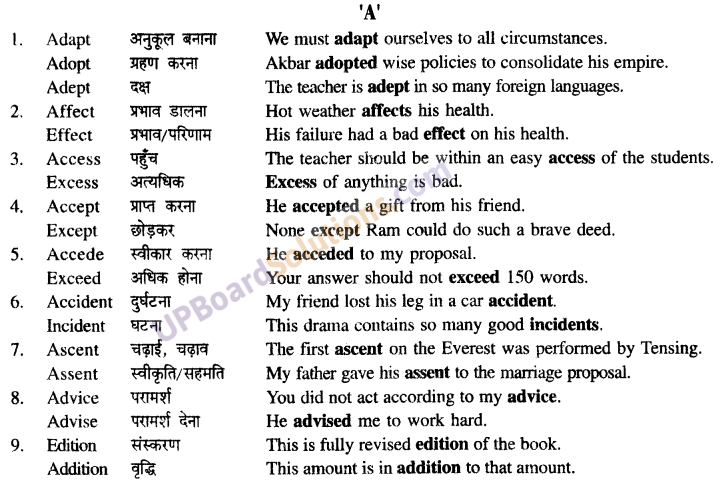
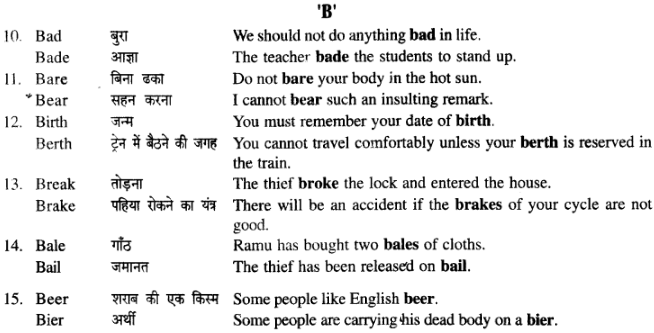
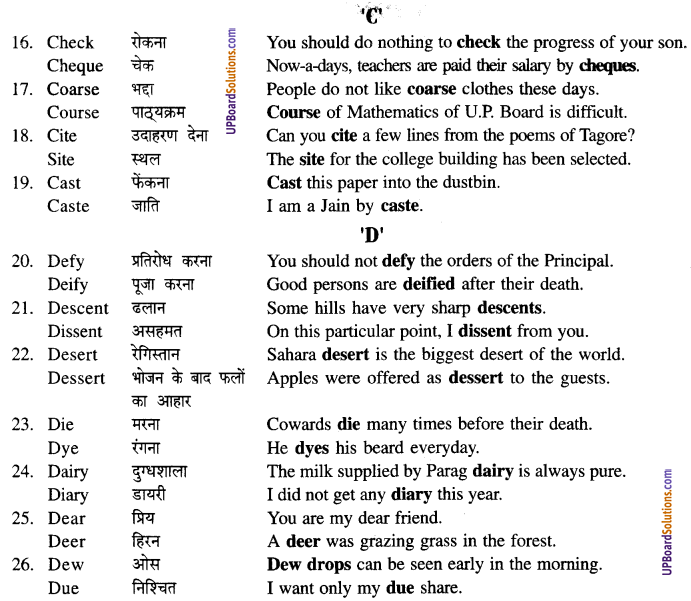
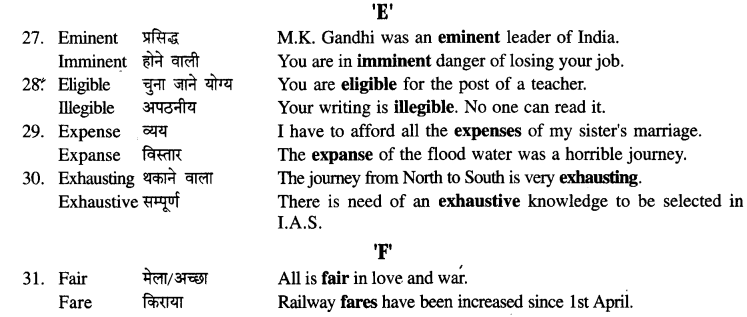
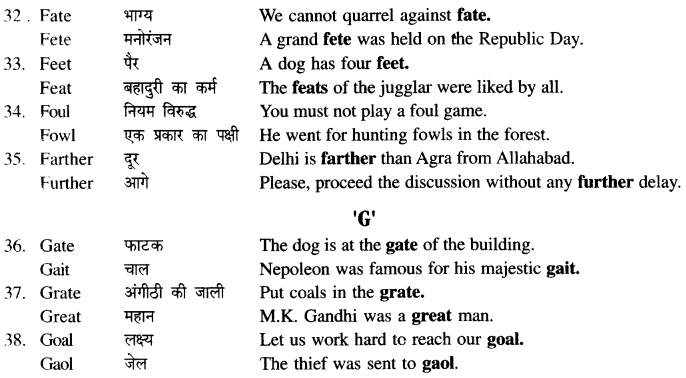
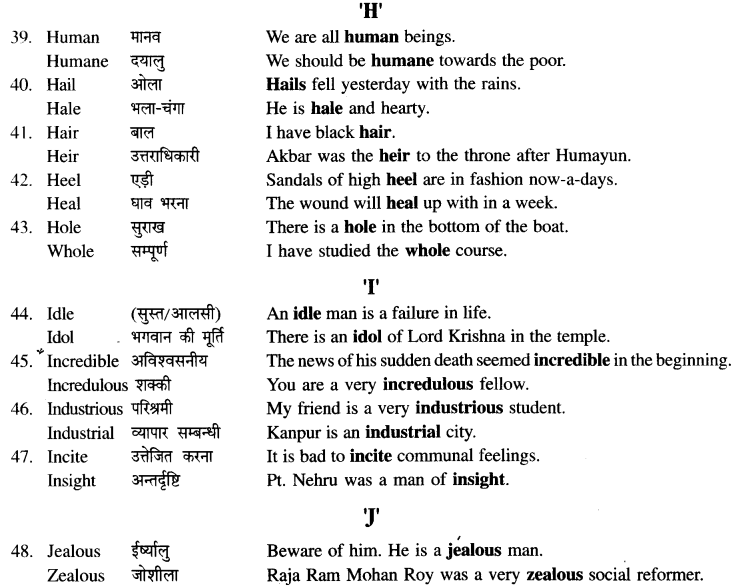
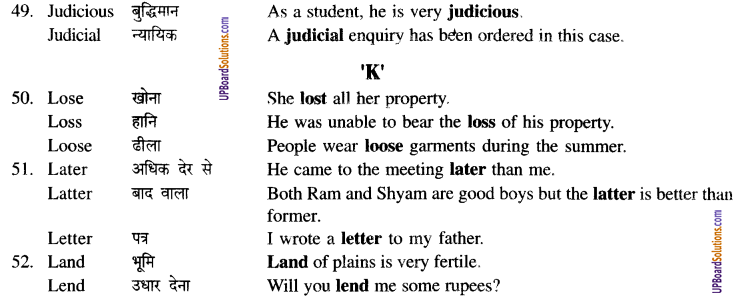
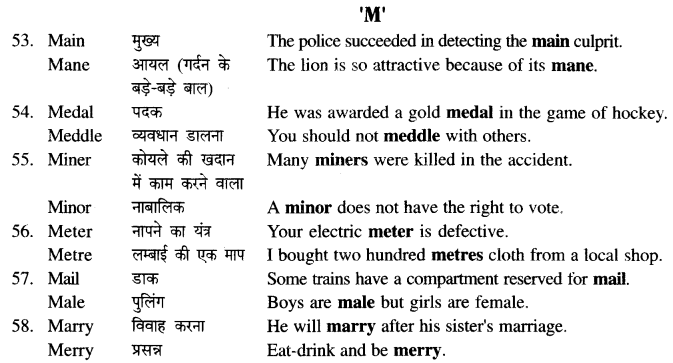
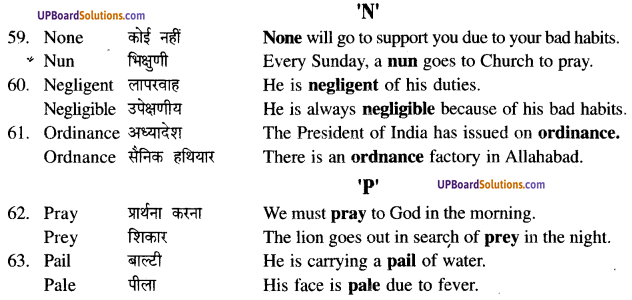
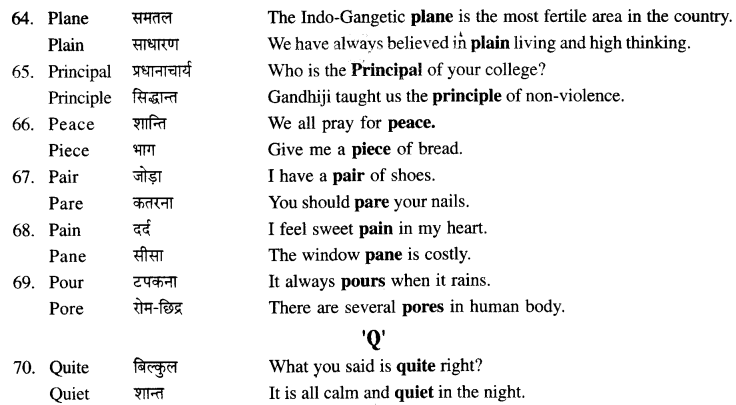
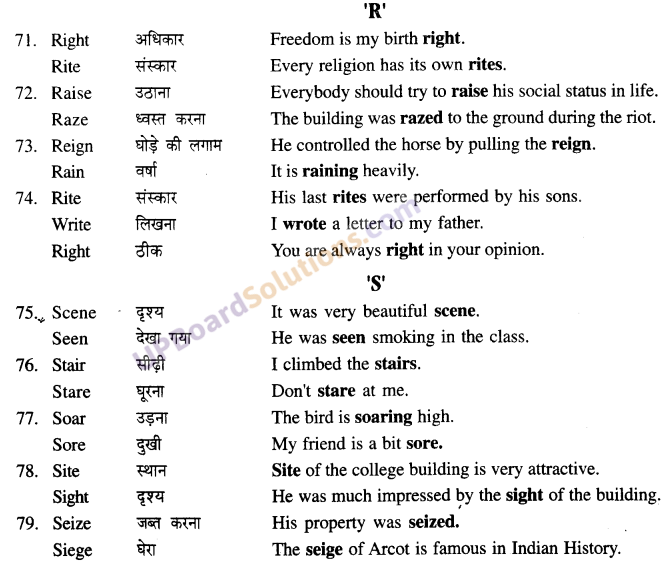
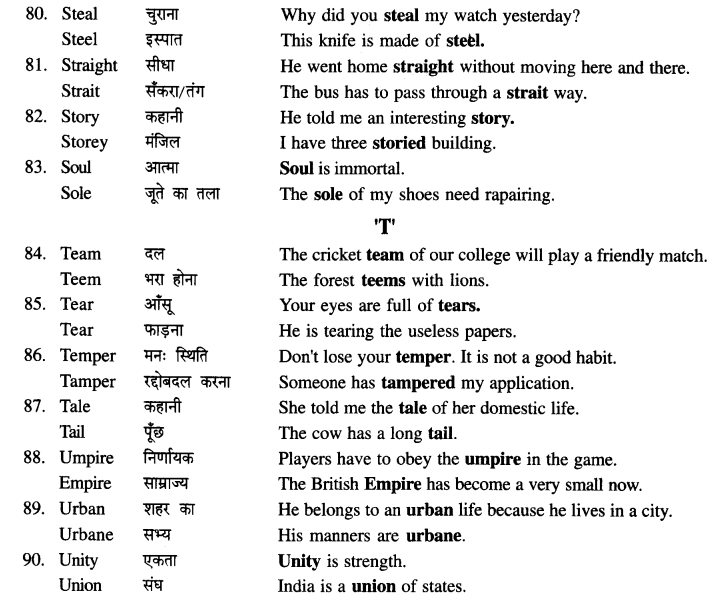
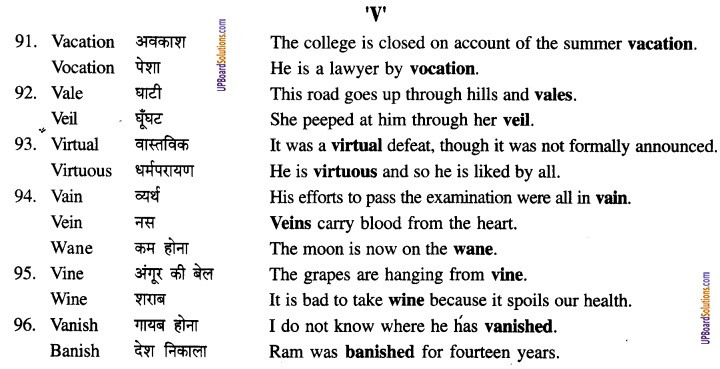
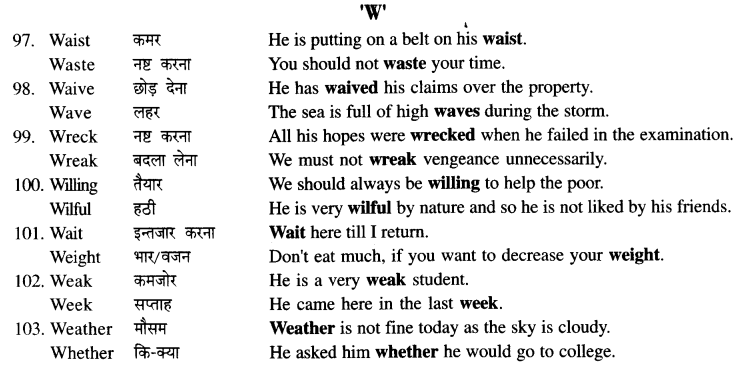
![]()
![]()



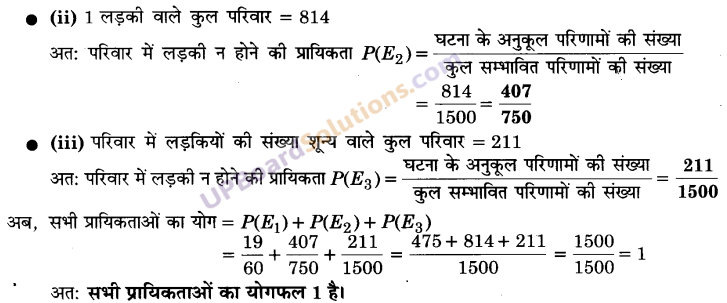
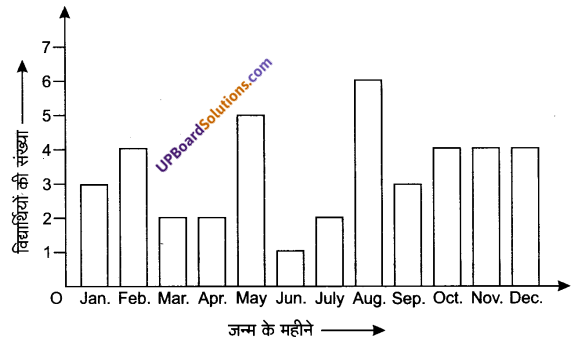




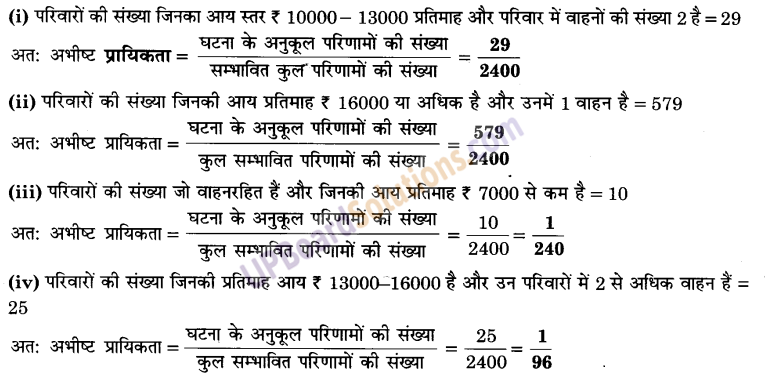

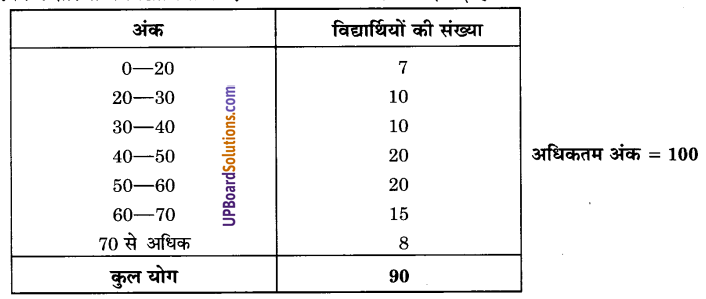






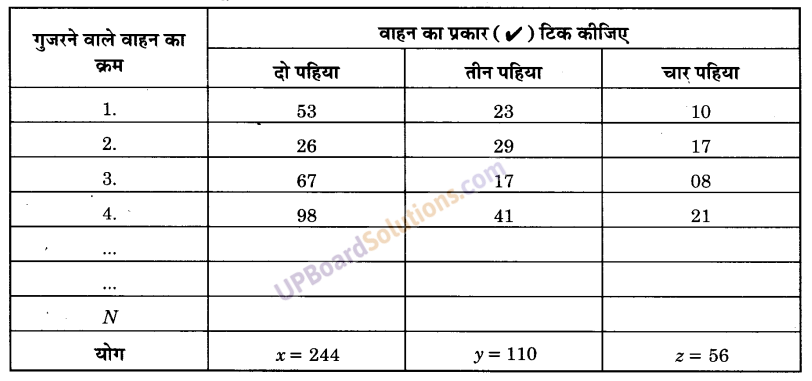



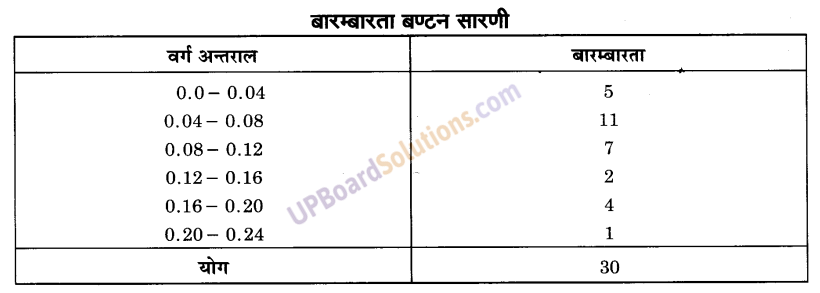

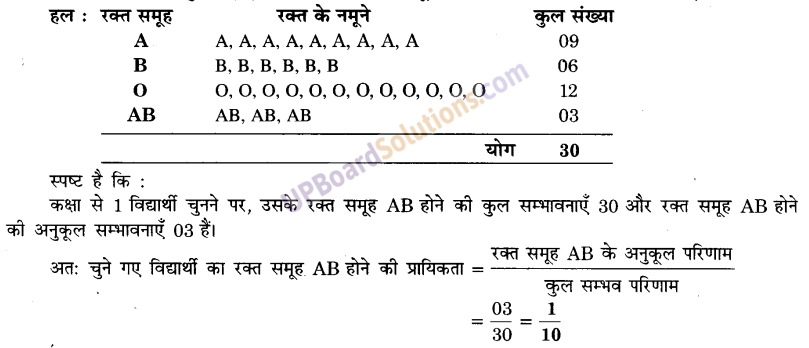

















































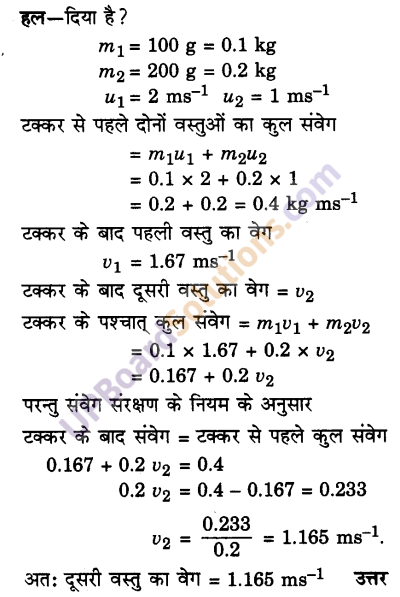
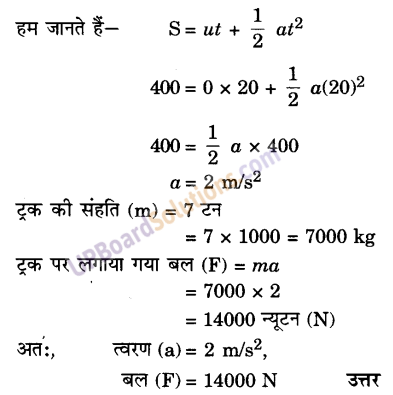
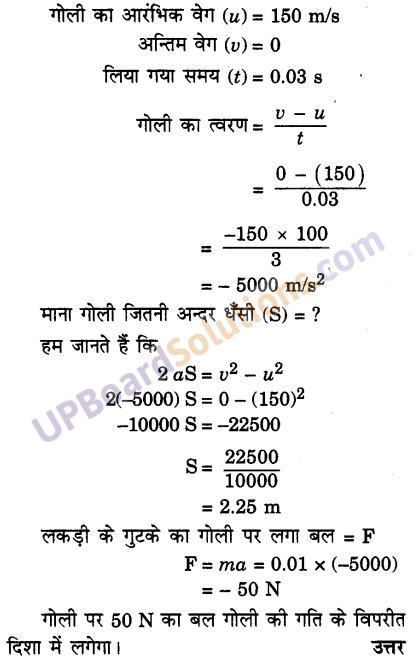
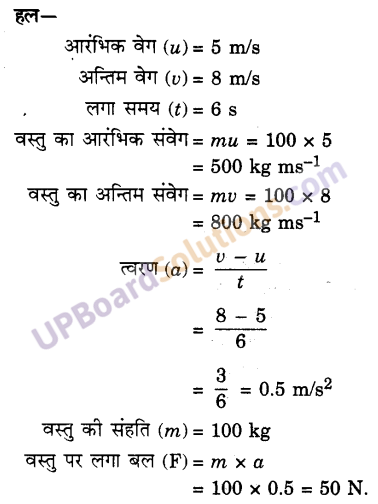
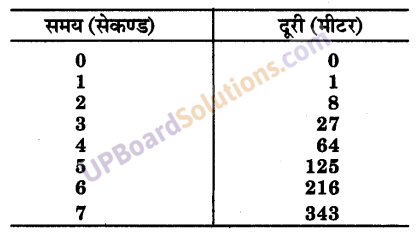
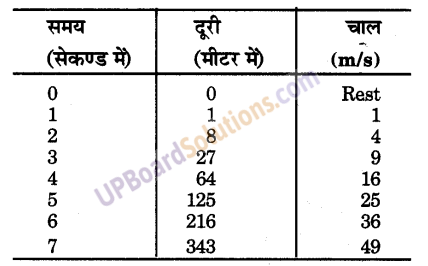
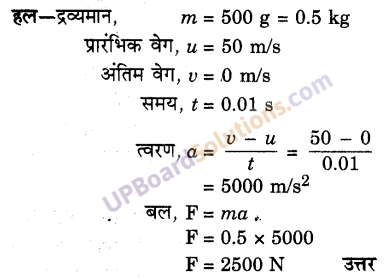
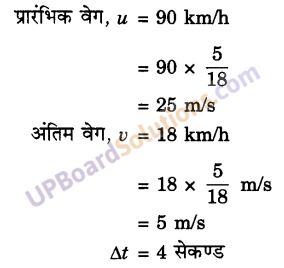
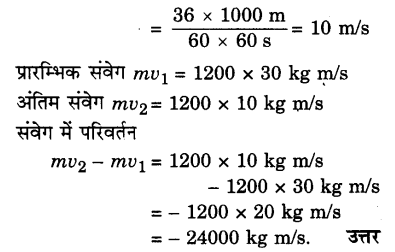
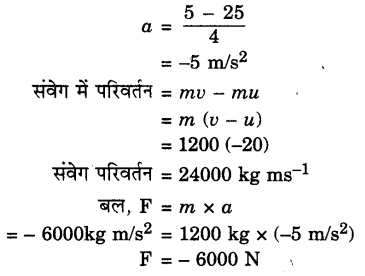 दाब का मात्रक- न्यूटन/मीटर या पास्कल।।
दाब का मात्रक- न्यूटन/मीटर या पास्कल।।


